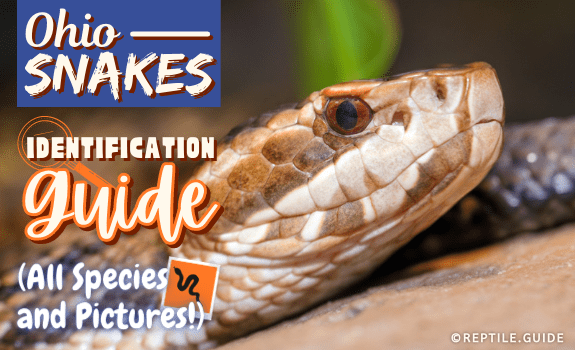Ohio snakes vary significantly in shape and form. From venomous snakes like the Copperhead to harmless species like the worm snakes, the diversity is amazing.
Perhaps as a result, snakes have a long and honored history in the area. Monuments like the snake mound in Ohio seem to point toward people worshiping these creatures in the past.
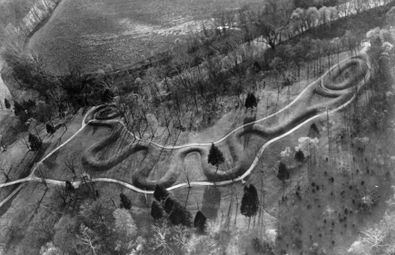
Image credit: u/pokettopals (via Reddit.com)
This identification guide takes a closer look at snakes in Ohio and will share basic information that can help you identify all 27 species.
In This Article
In Short
Among other things, this identification guide will share:
- How to deal with venomous snakes
- Basic tools for identifying Ohio snakes
- Which snakes are the most common in Ohio
- How to identify venomous snakes native to Ohio
I’ll also share Ohio snakes in pictures, and some of my favorite resources for dealing with snakes in this state.
Ohio Snake Identification Basics
Whether you’re in Idaho or India, several essential characteristics can help you identify snakes.
The most important things to keep an eye on include:
- Length
- Location
- Coloration
- Patterning
- Head shape
- Pupil shape
- Habitat type
Length
With snakes, there are two important lengths to consider: the average length and the maximum length.
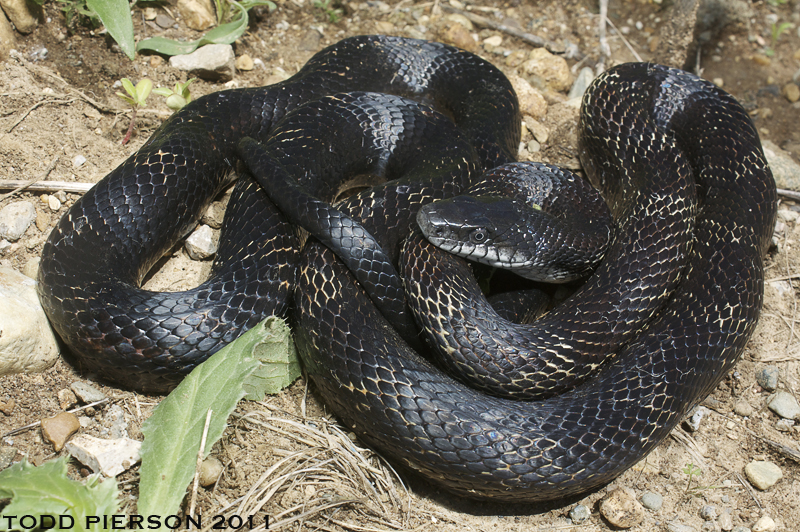
Image credit: Todd W Pierson (via CreativeCommons.org)
The average length is the size that a species usually reaches. Most snakes of a species never outgrow the average size.
However, in some cases, an individual will reach much longer lengths. This is usually when a snake grows up in almost perfect conditions.
These few overachievers grow to the limit of possibility for their species. Scientists use these lengths to determine the maximum length for that species.
For example, timber rattlesnakes can reach lengths of up to 74.5 inches. However, the average length for the species is 45 inches.
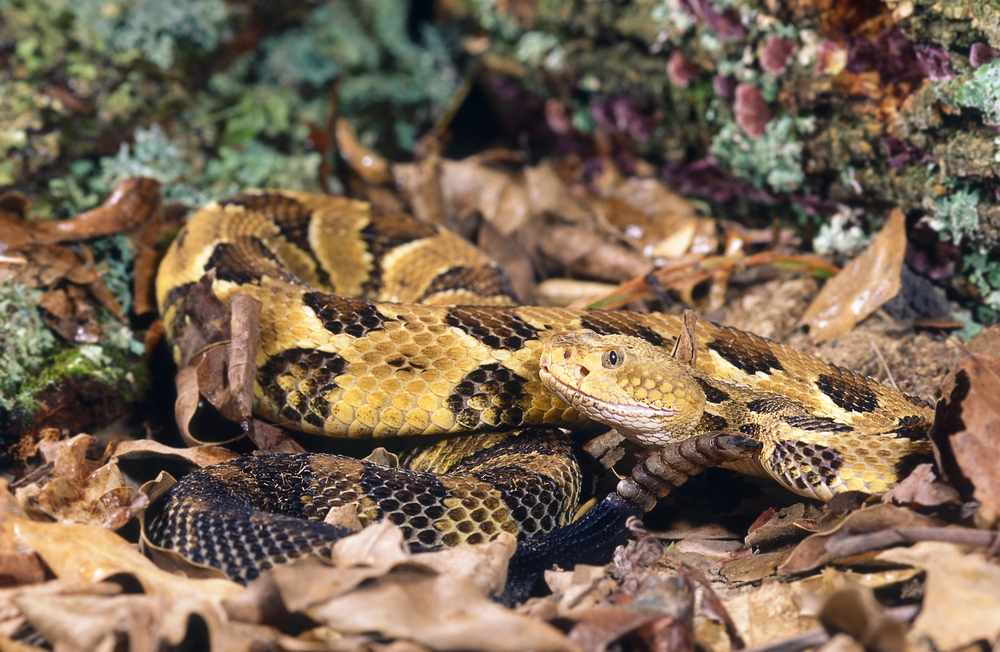
By knowing both the average and maximum length of the species, you can quickly tell whether any snake you find is possibly that type.
Locality And Habitat Type
Noting where you find a snake, both geographically and in terms of habitat, is essential.
Most snakes have a well-defined distribution range, which they won’t leave. The snakes in Northeast Ohio won’t be the same as those in Central Ohio.

Nor will the snakes in Southern Ohio be the same as those in Northwest Ohio. Taking note of exactly where you find a snake allows you to compare the location against a distribution map.
Some snakes, like the garter snakes, are called garden snakes because they’ll make themselves at home anywhere, including gardens.
However, most other snakes prefer a specific habitat type. For example, timber rattlesnakes prefer wooded mountainsides, while water snakes only live near freshwater.
Take note of the habitat where you see a snake, as it can help to identify the snake.
Head And Pupil Shape
Different Ohio snakes have different head shapes and pupil shapes.
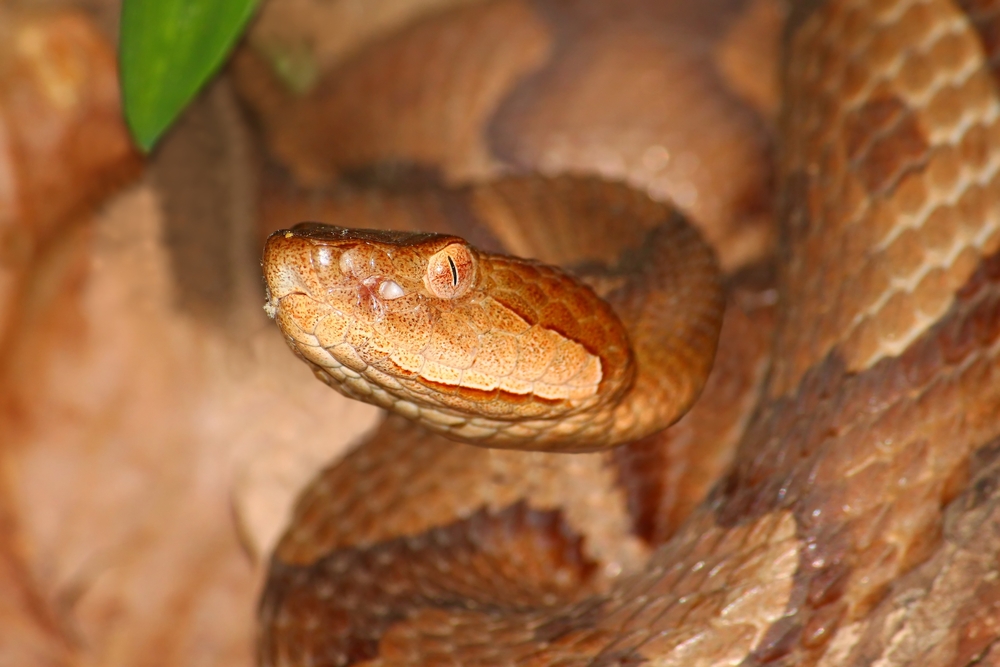
Among snakes in general, you may notice the following pupil shapes:
- Round
- Horizontal
- Vertical (slit-shaped)
In Ohio, you’ll only encounter round and slit-shaped pupils. Only the pit vipers have vertical pupils. All the other species have round pupils.
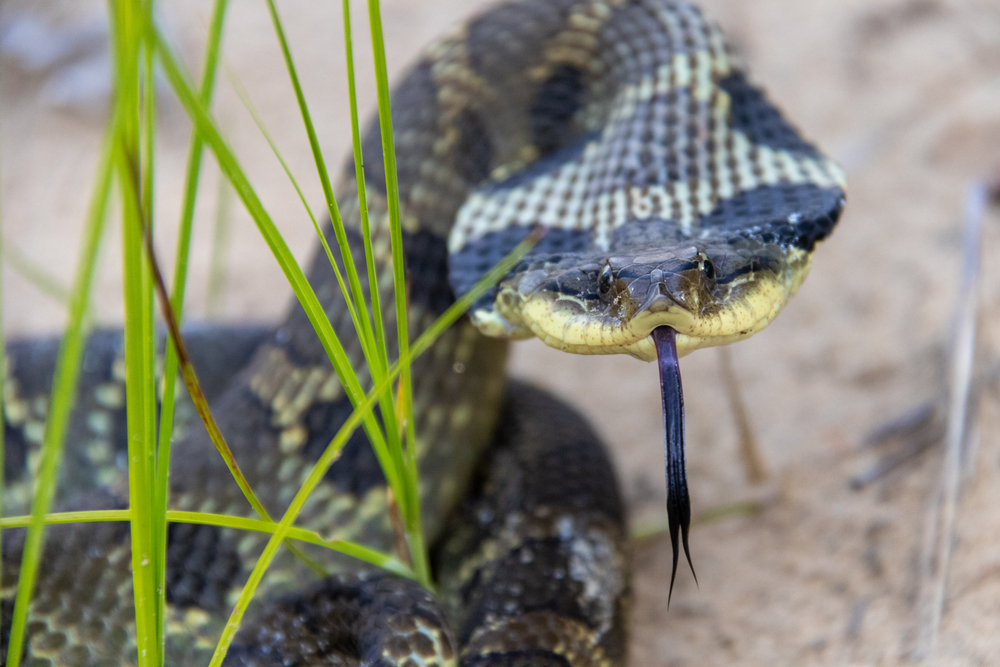
Different groups of snakes also have differently-shaped heads. For example:
- The Eastern milk snakes have rounded heads no wider than their bodies.
- Pit vipers have wide heads, unlike most of the other snakes native to Ohio.
- Garter snakes have elongated heads that are the same width as their bodies.
- The Eastern hog-nosed snake has a broad, flattened head that’s absolutely distinctive.
Color And Patterning
While coloration and patterning vary significantly, even within a single species, they can still be useful identification characteristics.
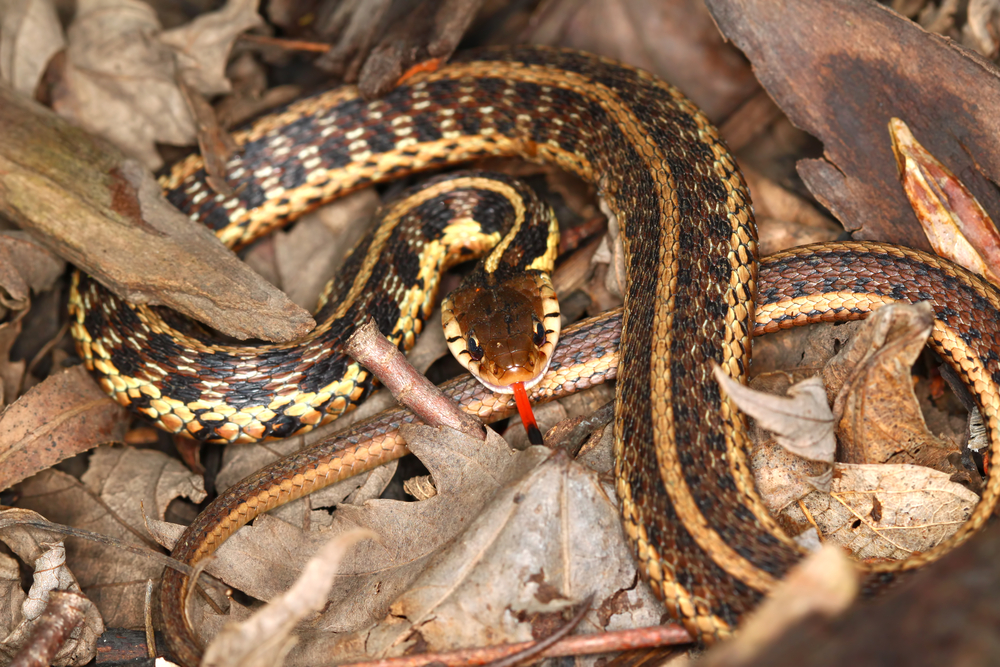
For example, the Eastern ribbon snakes have long vertebral stripes that you’ll never see in the water snakes or green snakes.
If you see black snakes in Ohio, you won’t go looking at the garter snakes or green snakes, but the black rat snakes are likely candidates.
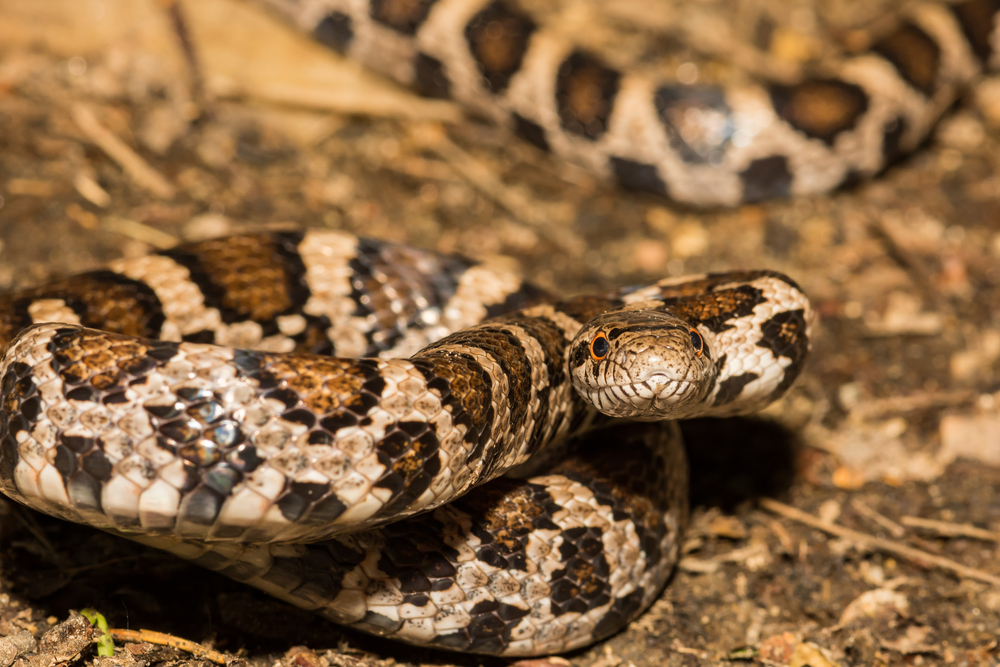
Color should only be a guiding characteristic, and never a conclusive one. Northern red-bellied snake populations and garter snake populations both sometimes produce melanistic snakes.
These animals have excessive pigmentation which makes them black. Many other aberrations (unusual variations) are possible, so never rule out a species on color alone.
Quickly Identifying Venomous Snake Species
Since there are only three types of venomous snakes in Ohio, identifying them is relatively easy. The fact that they’re all pit vipers makes it even easier.
All these snakes share most of the following characteristics:
- Large eyes with vertical pupils
- Stout bodies with strong musculature
- Neutral colors that blend well with leaf litter or stony backgrounds
- A tail that’s adapted to form a “rattle” (only in timber rattlesnakes and the Massasauga)
- Wide heads with heat-sensitive pits between the eyes and nostrils (they look triangular when seen from above)
Fun Fact: There are no poisonous snakes in Ohio. If something kills you when you bite it, it’s poisonous. When something can kill you when it bites you, it’s venomous.
These snakes also tend to wrap themselves in tightly rolled coils with the tail sticking out in an upward position. Their heads often lie ready to strike if they happen to see prey or a predator.
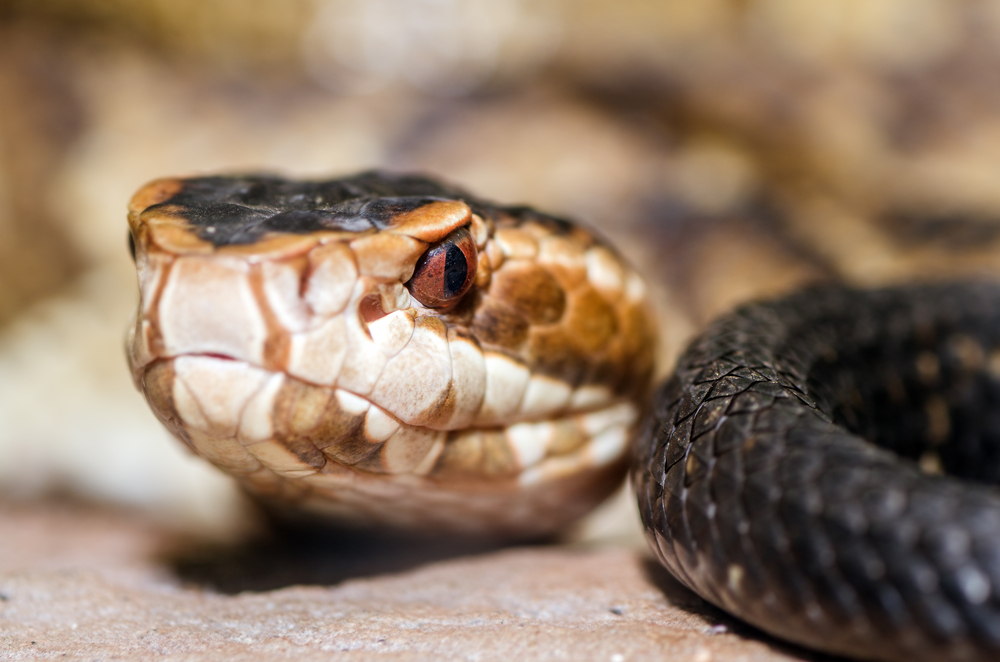
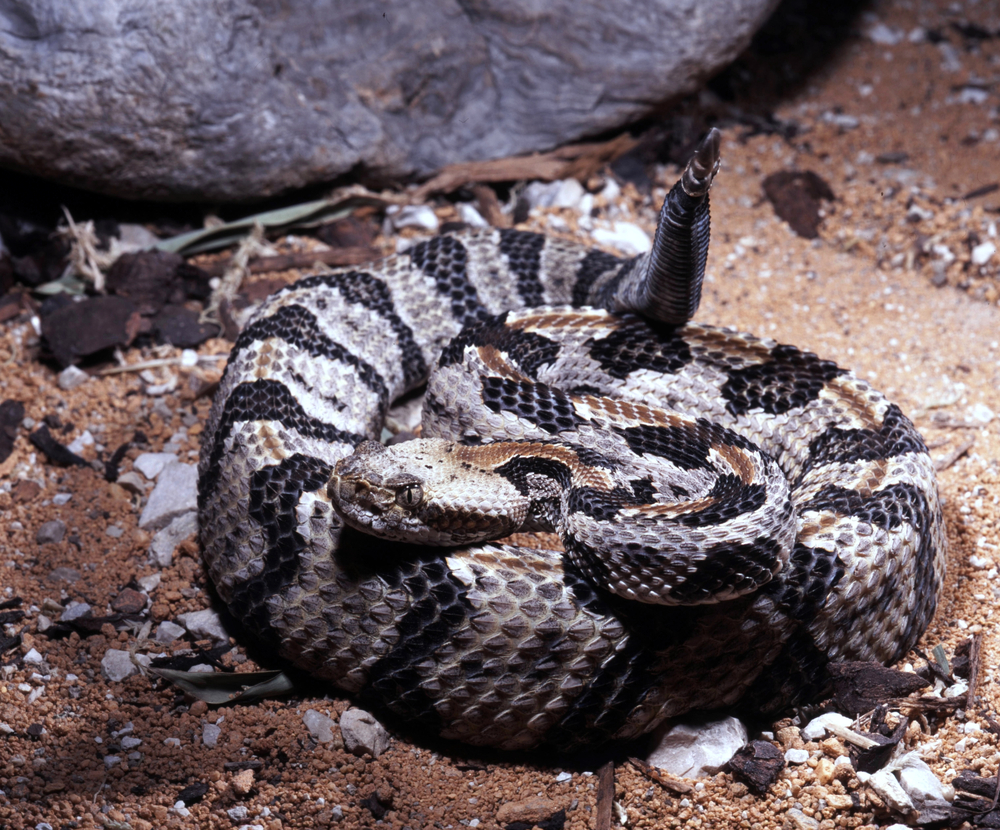
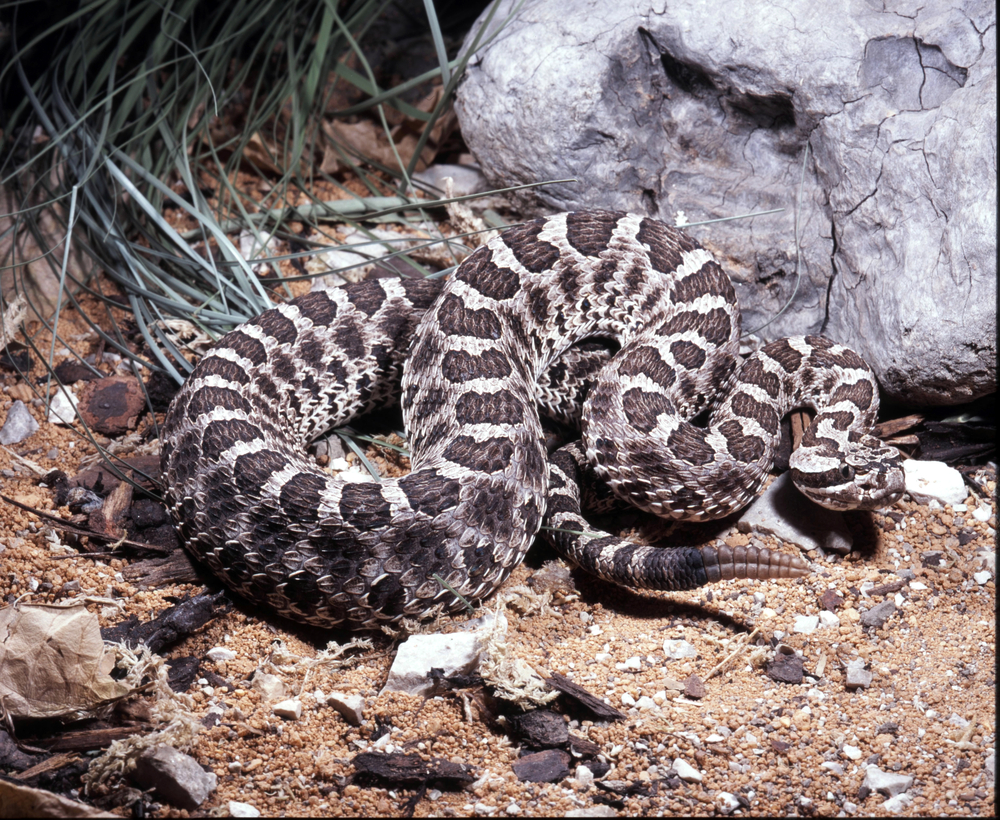
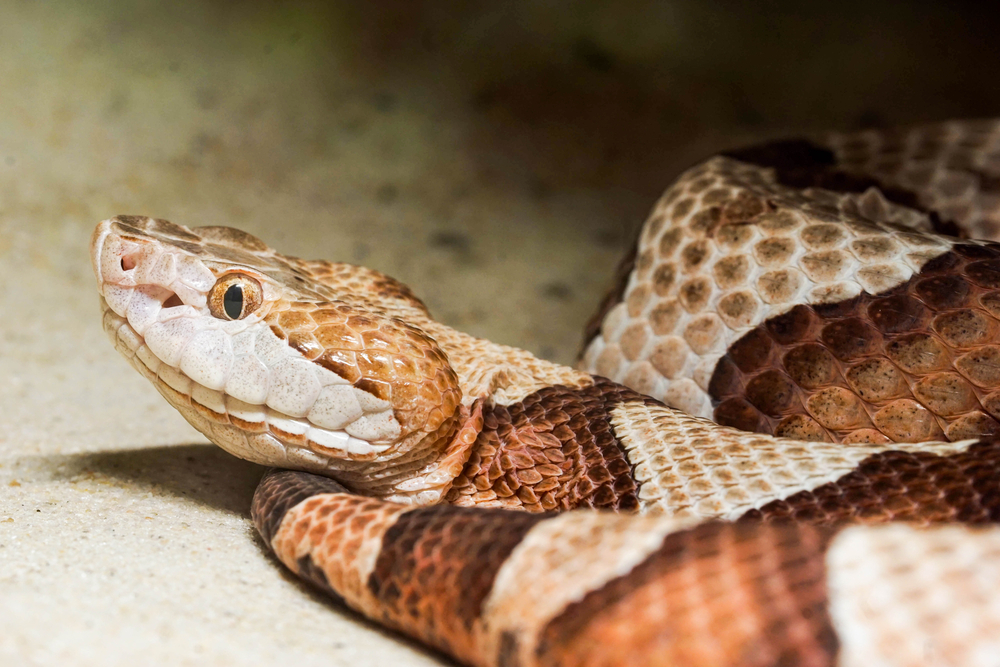
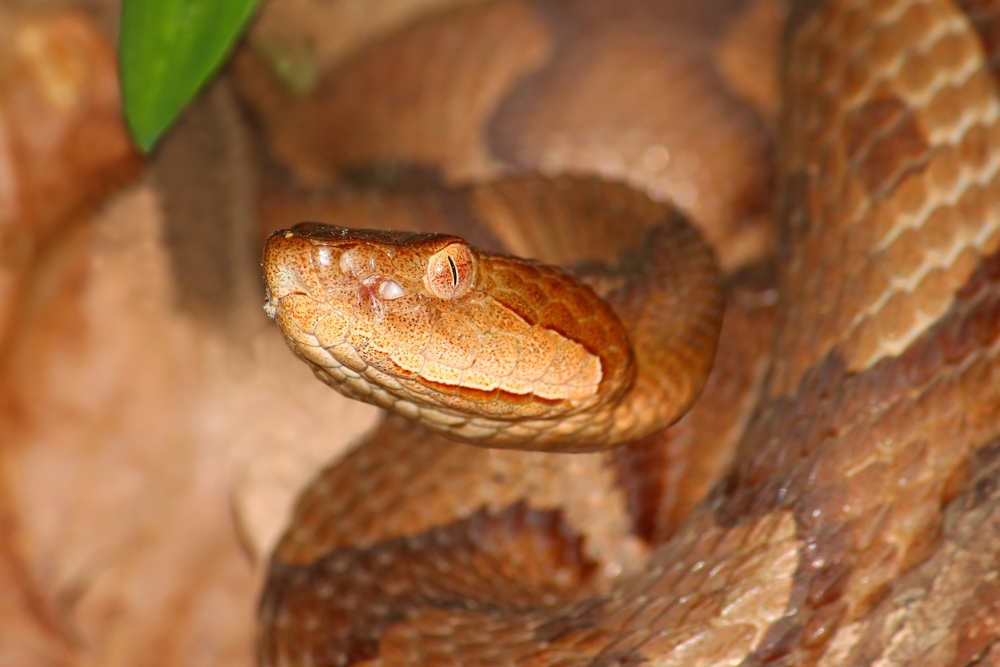
If you see a well-camouflaged snake, wrapped into a tight coil, and not trying to slither away, there’s a good chance it’s a pit viper.
Which Snakes Live in Ohio?
There are around 25 species of snakes in Ohio, with several more making guest appearances.
Three of the species in the state are endangered and protected by either federal or state law, specifically:
- Clonophis kirtlandii – Kirtland’s Snake
- Sistrurus catenatus – Massasauga
- Nerodia erythrogaster neglecta – Copper-bellied Water snake
Ohio has three venomous snake species, namely:
- Crotalus horridus – Timber Rattlesnake
- Sistrurus catenatus – Massasauga
- Agkistrodon contortrix – Eastern Copperhead
The rest of their approximately 25 species are non-venomous. Many of them can be divided into one of a few main groups:
Kingsnakes and Milksnakes
-
- Lampropeltis nigra – Black Kingsnake
- Lampropeltis triangulum – Eastern Milk snake
Green Snakes
-
- Opheodrys aestivus – Rough Green snake
- Opheodrys vernalis – Smooth Green snake
Rat Snakes and Fox Snakes
-
- Pantherophis vulpinus – Eastern Fox Snake
- Pantherophis obsoleta – Black Rat Snake
- Pantherophis spiloides – Gray Rat Snake
Brown Snakes
-
- Storeria dekayi – Dekay’s Brown snake
- Storeria occipitomaculata – Northern Red-bellied Snake
Garter Snakes
-
- Thamnophis radix – Plains Garter Snake
- Thamnophis butleri – Butler’s Garter Snake
- Thamnophis saurita – Ribbon Snake
- Thamnophis sirtalis – Common Garter Snake
- Thamnophis brachystoma – Short-headed Garter snake
Water Snakes
-
- Nerodia sipedon – Common Water snake
- Nerodia erythrogaster neglecta – Copper-bellied Water snake
Most of the other snakes in the region are individual representatives of their genera:
- Virginia valeriae – Smooth Earth snake
- Clonophis kirtlandii – Kirtland’s Snake
- Carphophis amoenus – Eastern Worm Snake
- Coluber constrictor – North American Racer
- Diadophis punctatus – Northern Ring-necked Snake
- Regina septemvittata – Queen snake
- Heterodon platirhinos – Eastern Hog-nosed Snake
All of these species fit into two main families, specifically the families Colubridae and Viperidae. Let’s take a closer look:
Colubridae
The family Colubridae is the largest group of snakes in Ohio, and the largest snake family in the world.
Worldwide, this family contains around 249 genera, and around two-thirds of the world’s snakes.
Typically, snakes in this family are harmless, and none of the species in Ohio are venomous. This family includes many well-known snakes like:
- Milk snakes
- King snakes
- Water snakes
- Garter snakes
- Hognose snakes
Scientists often debate the characteristics of this family, resulting in a mishmash of different snakes and characteristics being incorporated into one family.
Viperidae
The family Viperidae is a considerably smaller family, but it contains many medically significant species, including some of the world’s most venomous snakes.
Viperidae contains around 36 Genera, and four subfamilies. Only one of the subfamilies, Crotalinae, is present in North America.
Snakes in this family all share certain characteristics, namely:
- Typically nocturnal
- Medically significant venom
- Stocky bodies with heavy musculature
- Long hollow fangs that operate on a hinge
- Most have large eyes with slit-shaped pupils
The Crotalinae, or pit vipers, also have heat-sensing pits and sometimes rattles. Most of the venomous species in the US, and all those in Ohio, are vipers.
What Snakes Eat in Ohio
Much of the fear related to snakes are the result of misunderstandings. Many people think that snakes are undiscerning predators that will as happily eat a human as anything else.
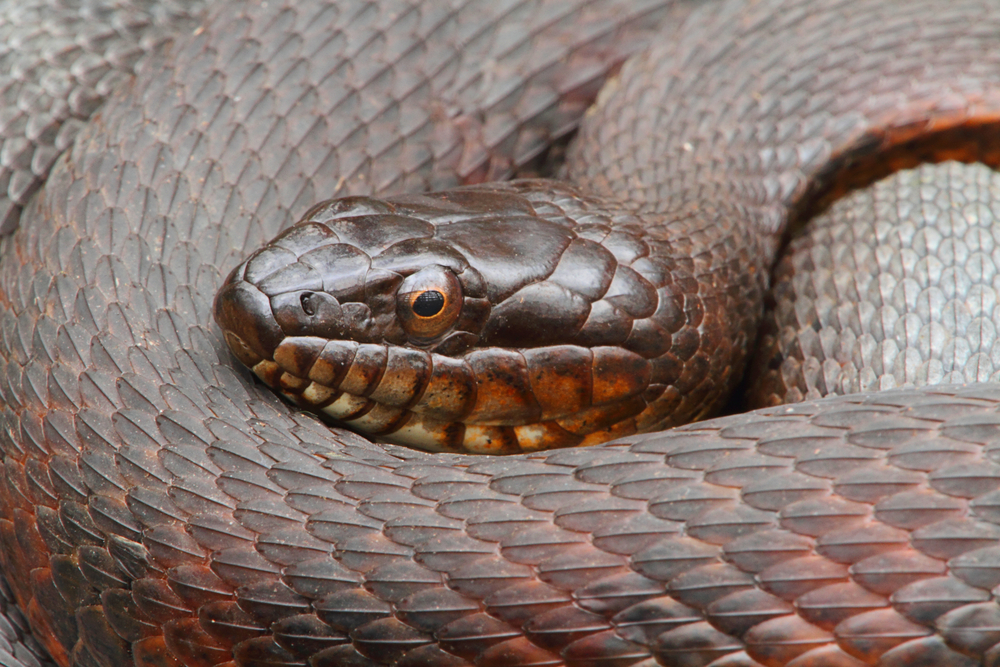
Nothing could be further from the truth, and many snakes have a very specific diet from which they rarely stray.
While some species like the garter snakes and rat snakes are generalists that will eat any small animals that they can catch, other species only feed on a specific type of animal.
Let’s take a closer look at some of the diets which Ohio snakes adhere to:
- The hognose snake is a specified predator that feeds almost exclusively on frogs, toads, and other amphibians.
- The ring-necked snake will take other prey when the opportunity arises, but it feeds almost exclusively on mollusks like slugs and snails.
- The queen snake is known as the crayfish snake in certain areas since it feeds almost exclusively on crayfish.
- Worm snakes are highly adapted predators that burrow in moist soils to feed on the larvae and adults of termites and ants.
- The water snakes are another group of specialized predators that feed almost entirely on fish and aquatic amphibians – which is why they always live near water.
While many other species are open to eating a greater variety, their limited size means that most species only feed on a few groups of animals.
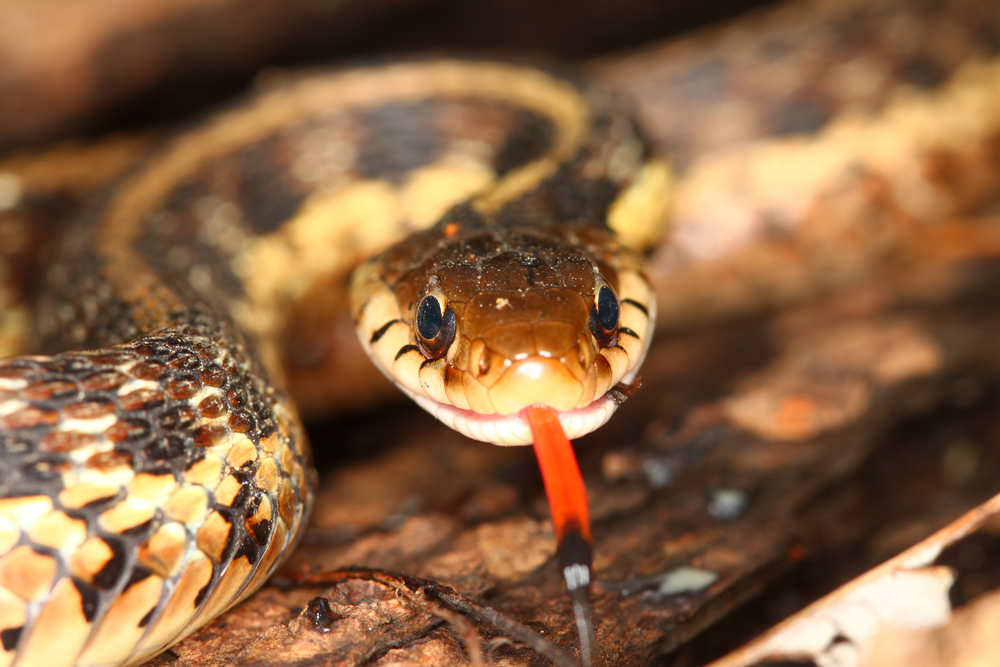
Rat snakes get their name because small rodents are their dominant food source. They can catch and eat these animals with ease.
Likewise, garter snakes generally feed on small rodents and amphibians.
Even the pit vipers, that have venom strong enough to take down a bison, prefer small animals like rats and mice.
Catching anything larger simply doesn’t make sense because they can’t swallow it. Since snakes can’t chew, they must catch prey that they can swallow whole.
So, if you’ve been worried about the snake in your garden trying to eat you, rest assured. It’s more likely to eat the mice that may become a pest in your home.
Most Common Snakes in Ohio
According to iNaturalist, the following ten species are the most common snakes in Ohio:
- Thamnophis sirtalis – Common Garter Snake
- Nerodia sipedon – Common Watersnake
- Storeria dekayi – Dekay’s Brown snake
- Pantherophis spiloides – Gray Rat snake
- Lampropeltis triangulum – Eastern Milk snake
- Diadophis punctatus – Ring-necked Snake
- Regina septemvittata – Queen snake
- Pantherophis vulpinus – Eastern Fox snake
- Coluber constrictor – North American Racer
- Storeria occipitomaculata – Red-bellied Snake
In the following sections, we’ll take a closer look at each of them, share some basic information, and tell you which characteristics are unique to each species.
Garter Snakes – Genus Thamnophis
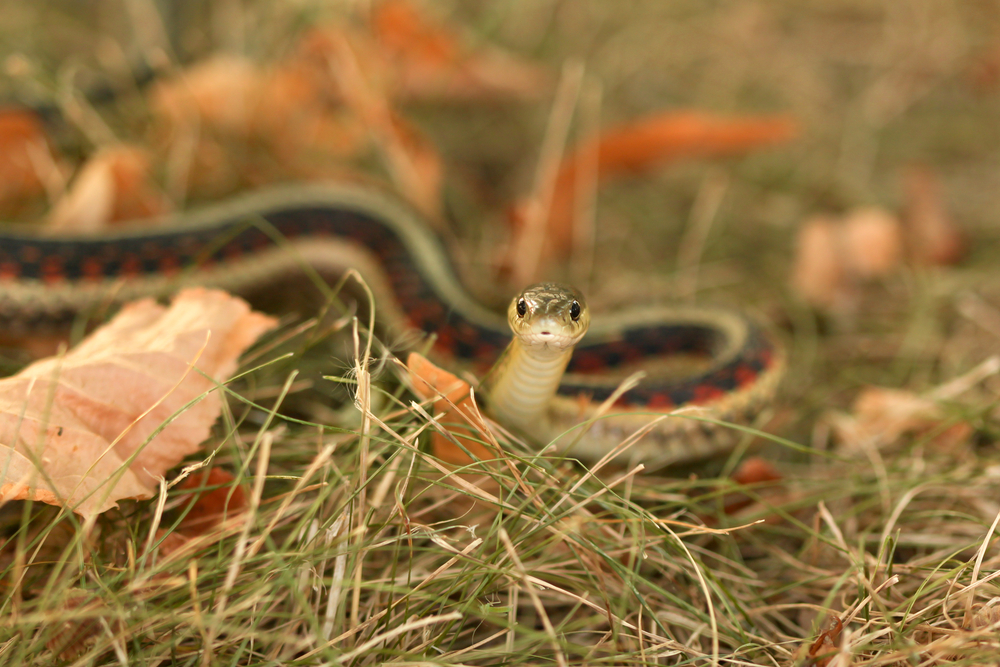
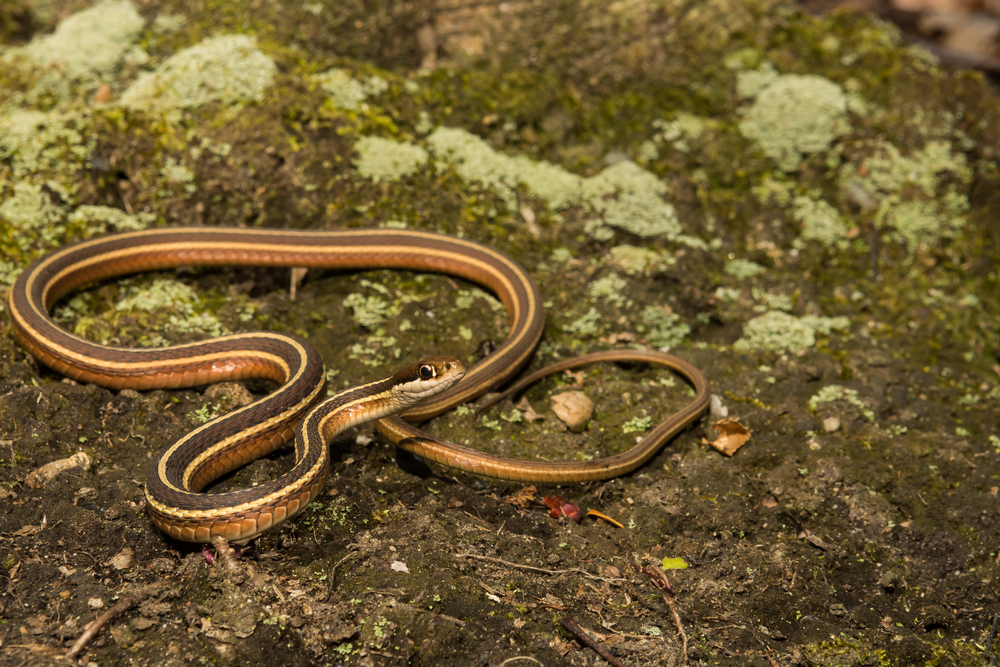
Finding a garter snake in Ohio is about as easy as tripping over a tree root. These snakes are common residents throughout most of North America.
However, Ohio has a larger complement than most states. The Buckeye State boasts five different species.
It’s difficult to identify a baby garter snake in Ohio – they can look quite similar at a young age.
Complicating things even further is the fact that most of the species are almost identical as adults.
| Scientific Name: | Thamnophis radix – Plains Garter Snake
Thamnophis butleri – Butler’s Garter Snake Thamnophis saurita – Ribbon Snake Thamnophis sirtalis – Common Garter Snake Thamnophis brachystoma – Short-headed Garter snake |
|---|---|
| Range: | Throughout the state |
| Adult Size: | Reaches lengths of up to 49 inches |
| Description: | Most garter snakes share the same basic characteristics. They have long narrow bodies, which feature between three and five vertebral stripes.
Their heads are short and usually somewhat glossy and they have round pupils. These snakes have exceptionally long tails. |
| Habitat: | Absolute generalists that are so common in gardens that they sometimes go by garden snakes.
Live happily in meadows and prairies but also wherever else food is readily available. |
| Venomous/Non-Venomous: | Non-venomous |
Water Snakes In Ohio – Genus Nerodia
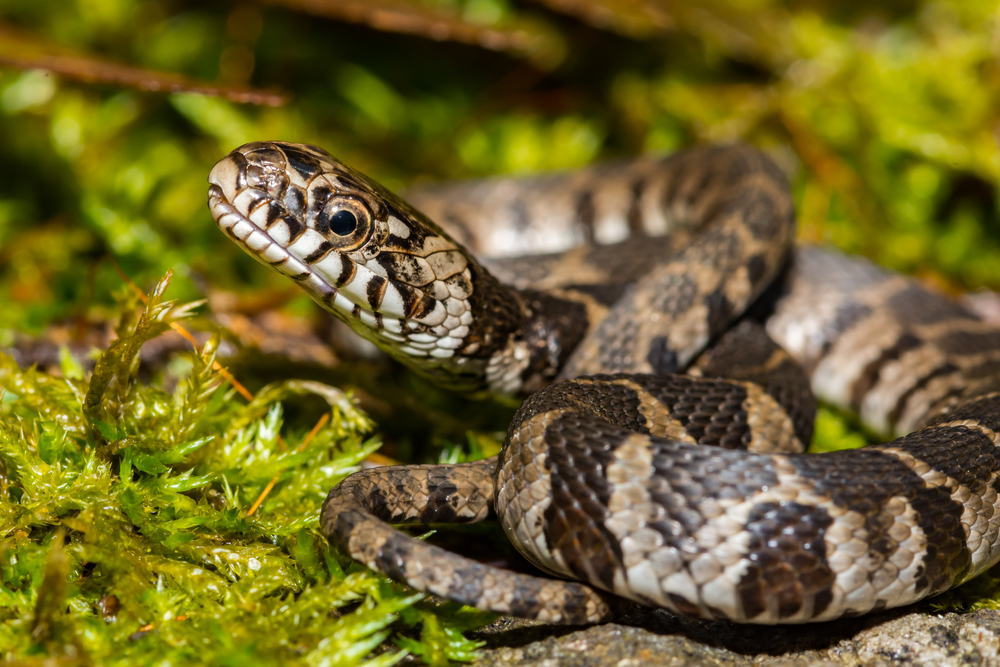
There are two types of water snakes in Ohio. The first is the common water snake, a citizen of large parts of the United States.
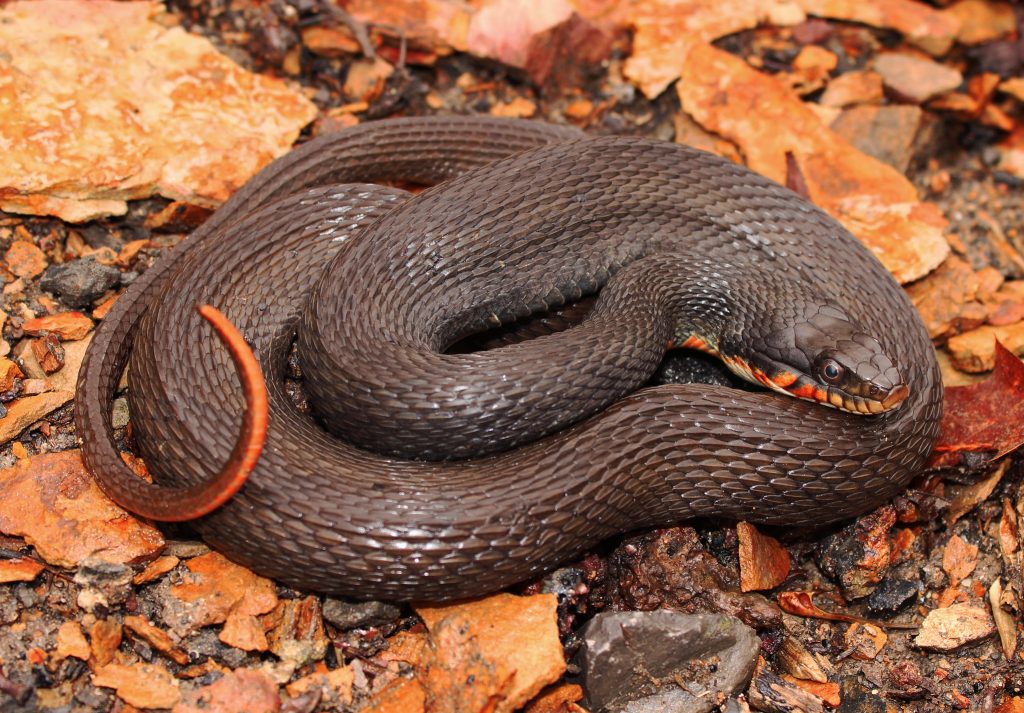
Image credit: 2ndPeter (via CreativeCommons.org)
The second, the Copper-bellied water snake, is an endangered species that’s protected by law. This species is endemic to the Central United States.
| Scientific Name: | Nerodia sipedon – Common Watersnake
Nerodia erythrogaster neglecta – Copper-bellied Watersnake |
|---|---|
| Range: | Throughout the state |
| Adult Size: | Reaches lengths of up to 55 inches |
| Description: | Water snakes have distinctly glossy heads with very large scales. Their heads are also slightly larger than the width of their bodies. They have round pupils.
The northern water snake is dark brown with bands in various shades of brown. The copper-bellied water snake has a black upper side with a copper-colored underside. |
| Habitat: | Marshes and swamps and wet floodplains.
These snakes only live where freshwater is abundant, and will only stray from them in times of drought. |
| Venomous/Non-Venomous: | Non-venomous |
Dekay’s Brown Snake – Storeria dekayi
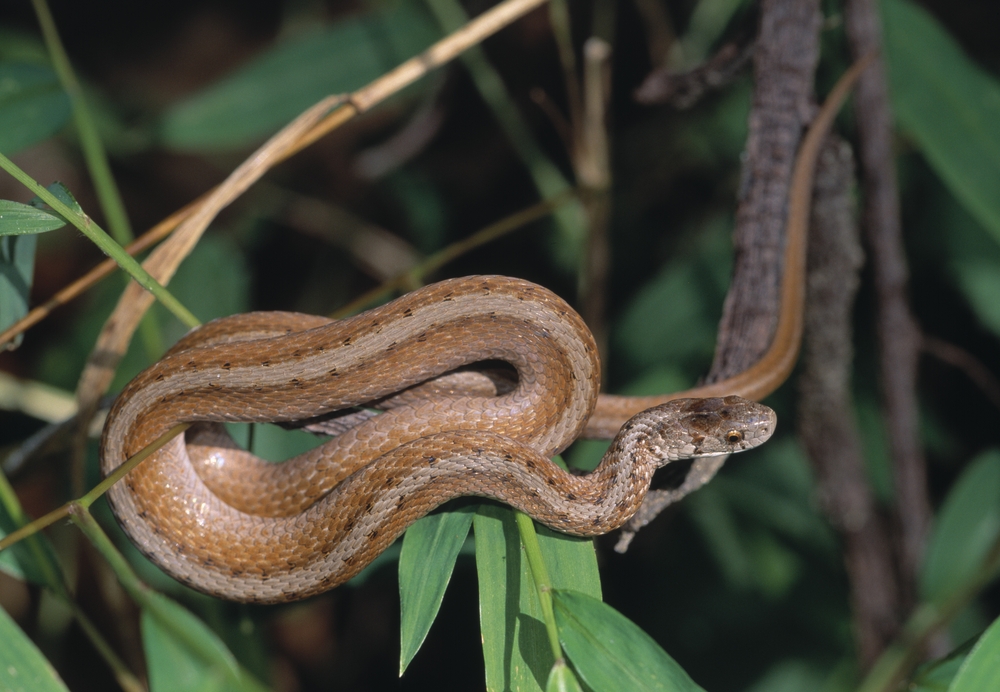
Dekay’s brown snake is a common inhabitant of forested regions in the US. It happily dwells anywhere with lots of vegetation and moist soils.
It has an unusual diet compared to the snakes most people are familiar with and feeds mainly on slugs and snails.
The Blunt-Headed Tree Snake is a pet snake with a similar diet.
| Scientific Name: | Storeria dekayi |
|---|---|
| Range: | The West and North of the state |
| Adult Size: | Up to 13 inches |
| Description: | The brown snake is a small snake with a stout build. It’s brown with bands of a different shade of brown.
Its head is quite short and slightly glossy with round pupils. |
| Habitat: | Forests, woodlands, and other vegetated areas with damp soils. |
| Venomous/Non-Venomous: | Non-venomous |
Gray Rat Snake – Pantherophis obsoleta
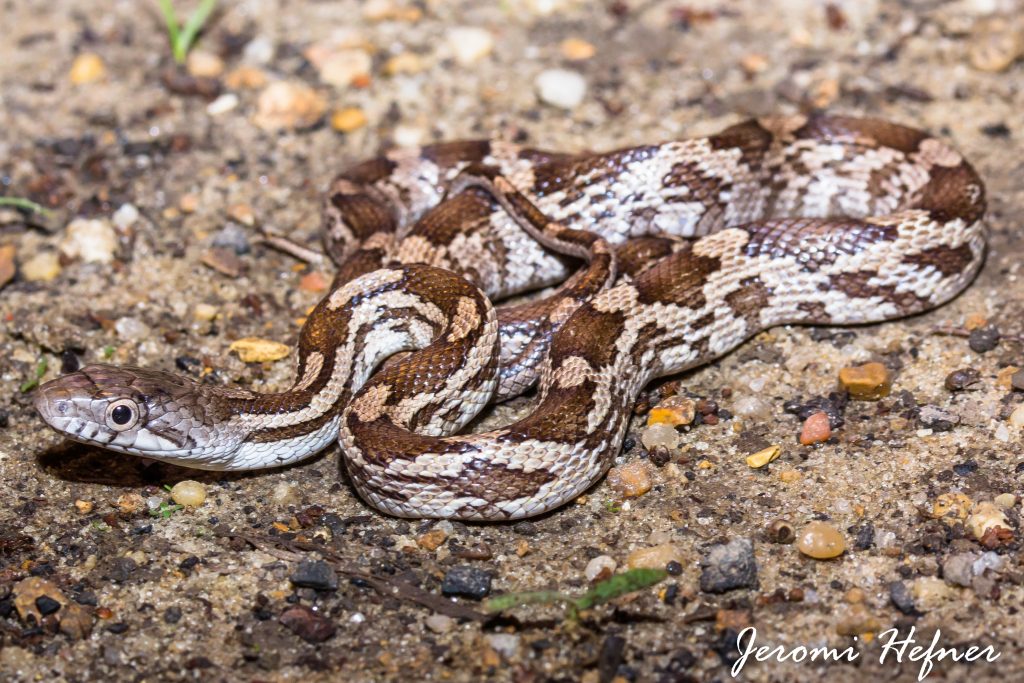
Image credit: Jeromi Hefner (via CreativeCommons.org)
As its name suggests, the gray rat snake feeds primarily on rodents. It’s a common species with no preferred habitat type.
As long as the prey is plentiful, and conditions are easy, this snake is happy to live there. Several other rat snakes occur in the region, but I’ll discuss those later on.
| Scientific Name: | Pantherophis spiloides |
|---|---|
| Range: | Throughout the state |
| Adult Size: | Up to six feet |
| Description: | A long muscular snake with a gray background and dark gray or brown blotches.
It looks much like a corn snake except that the colors are muted. Its head is no wider than its body and its pupils are circular. |
| Habitat: | A habitat generalist that is often seen in meadows and prairies but will happily live wherever there is a profusion of rodents and other small animals. |
| Venomous/Non-Venomous: | Non-venomous |
Eastern Milksnake – Lampropeltis triangulum
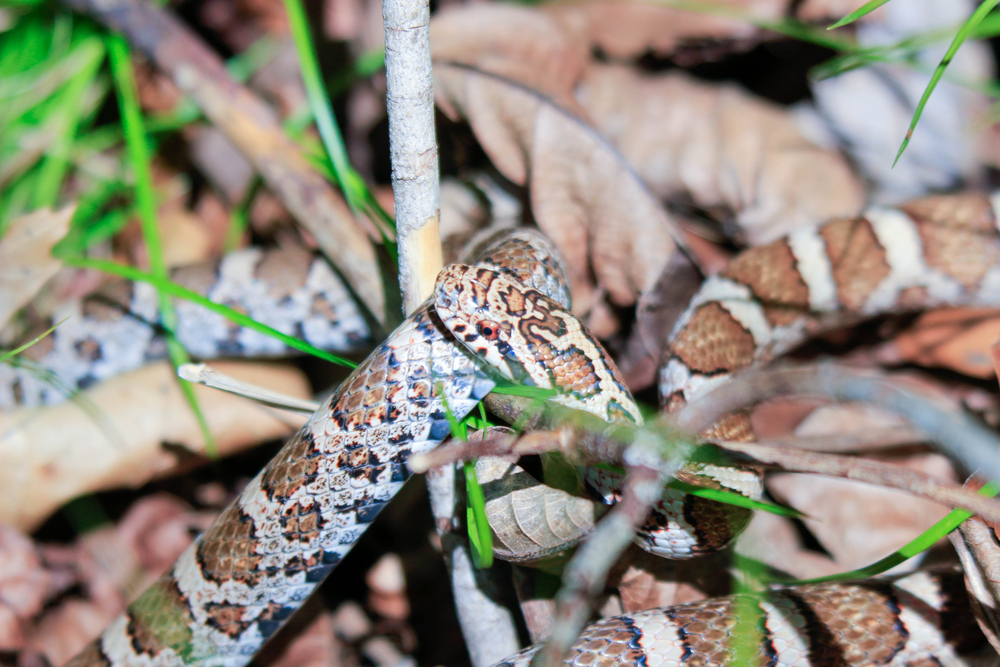
The Eastern milk snakes are striking animals that are entirely harmless. As with rat snakes, they tend to be habitat generalists.
One of the characteristic traits of this species is that it has highly variable patterning. In captivity, breeders have produced multiple milk snake morphs with significantly different patterns.
| Scientific Name: | Lampropeltis triangulum |
|---|---|
| Range: | Throughout the state |
| Adult Size: | Up to 36 inches |
| Description: | A brightly-colored snake that is banded in red, white, and black. Highly variable coloration and some snakes only have brown bands.
It has a well-rounded head with round pupils, and it also has a well-defined tail. The body is robust as with most constrictors and the head is no wider than the body. |
| Habitat: | A habitat generalist but it prefers areas with lots of vegetation. It may also be found on sand dunes and beaches, so you can’t rule out any habitat type. |
| Venomous/Non-Venomous: | Non-venomous |
Ring-Necked Snake – Diadophis punctatus
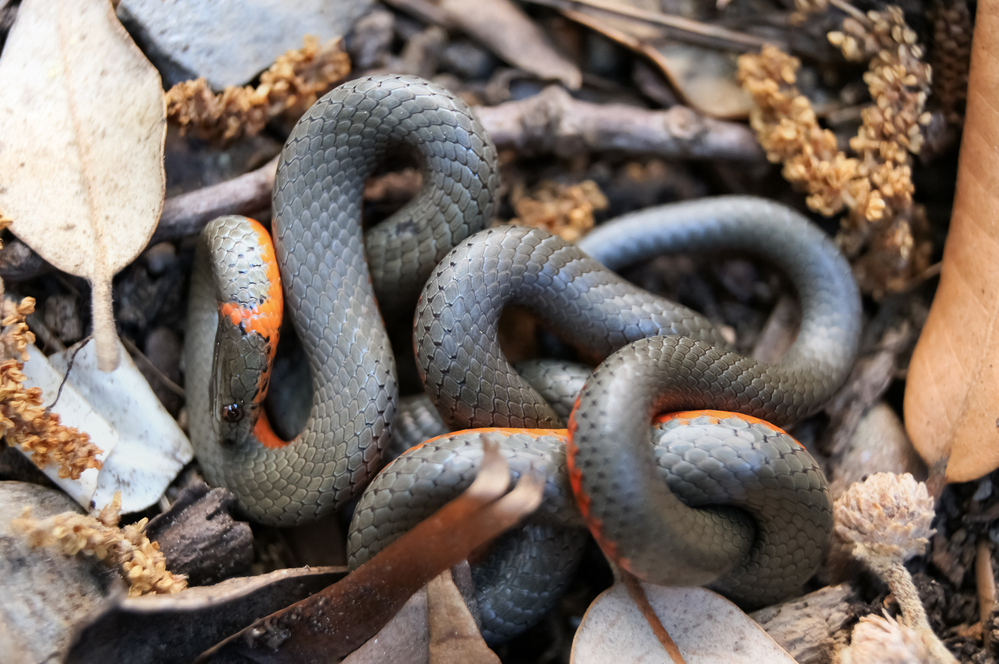
The ring-necked snake or ringneck snake is a common species that dwells in moist woodlands, gardens, and similar locations. It gets its name from a single ring around its neck.
The color of its neck and belly serves as a warning for potential predators. It’s a bit of a scam, since these snakes are harmless.
| Scientific Name: | Diadophis punctatus |
|---|---|
| Range: | Absent in the Central and Central-Western regions of the state |
| Adult Size: | Up to 15 inches |
| Description: | A small snake with a black or brown color on the upper surface and a bright orange or red underside.
It has a short head behind which is a singular red or orange ring. Its body is short and stocky, and its pupils are round. |
| Habitat: | Forests, woodlands, and other heavily vegetated areas with moist soils. Specifically, those where slugs and snails are abundant. |
| Venomous/Non-Venomous: | Non-venomous |
Queen Snake – Regina septemvittata
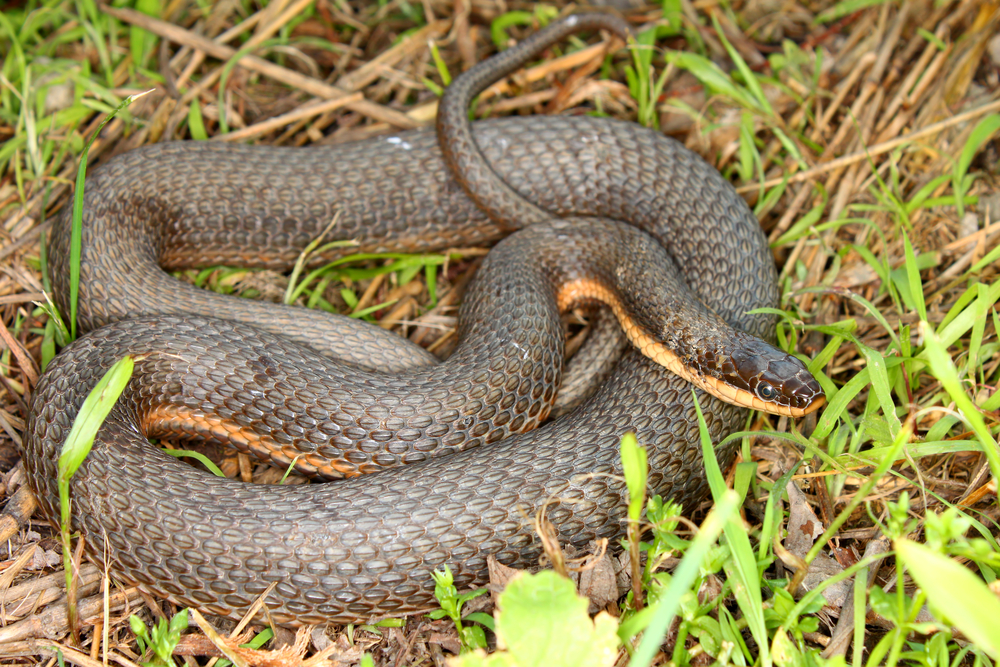
The Queen snake is a relatively unremarkable species that travels freely wherever food is abundant.
It prefers to feed on crayfish, which led to its other names of crayfish snake or crawdad snake.
| Scientific Name: | Regina septemvittata |
|---|---|
| Range: | Everywhere except in the Southeast of the state |
| Adult Size: | Up to 24 inches |
| Description: | This species has a somewhat unique appearance, which makes it relatively easy to distinguish.
It has a sharply-forked tongue and round pupils. A solid cream band runs around the side of the snake’s entire body including the head. The snake’s underside is banded with brown and cream stripes. The black or dark brown color of the snake is often extremely glossy. It has a long, well-defined tail. |
| Habitat: | This species only lives near water sources where crayfish are abundant. Habitats include swamps, marshes, and floodplains next to rivers. |
| Venomous/Non-Venomous: | Non-venomous |
Eastern Fox Snake – Pantherophis vulpinus
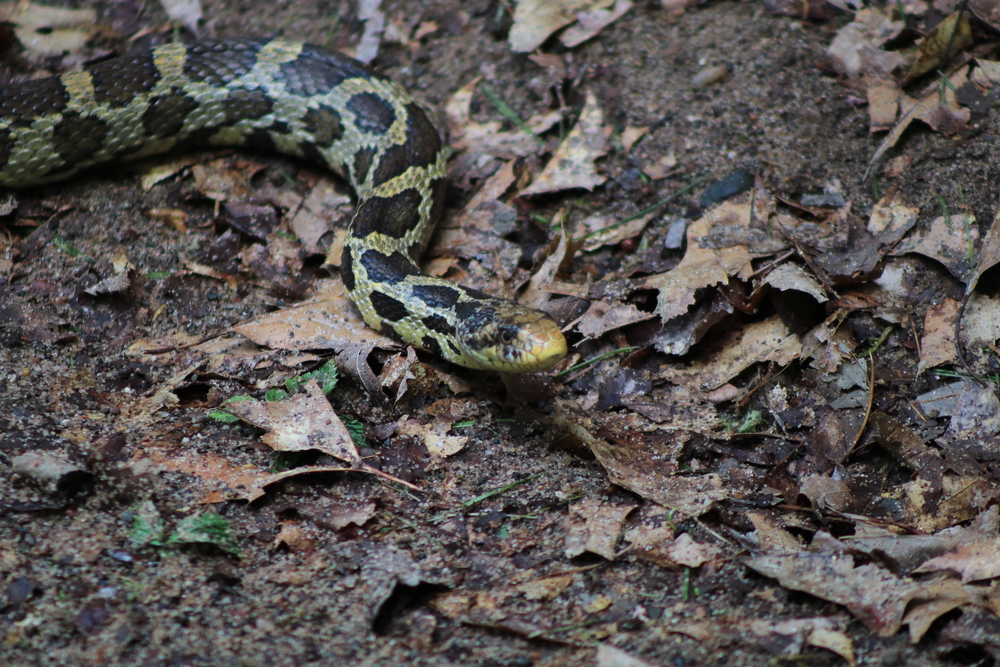
The Eastern fox snake is a species of rat snake that takes the place of the corn snake in Ohio. The two snakes are similar, both in appearance and habits.
This species happily dwells in any place with plenty of cover and sufficient food supplies. You’ll often see these snakes near barns and abandoned fields, where mice are plentiful.
| Scientific Name: | Pantherophis vulpinus |
|---|---|
| Range: | Throughout the state |
| Adult Size: | Up to six feet |
| Description: | A robust, boldly patterned snake with a yellowish-brown background and dark brown or black blotches.
The head is long and slightly glossy, with round pupils. The scales are keeled which gives the snake a rough appearance. |
| Habitat: | A generalist, often seen in prairies and meadows but will live wherever food is most abundant. |
| Venomous/Non-Venomous: | Non-venomous |
North American Racer – Coluber constrictor
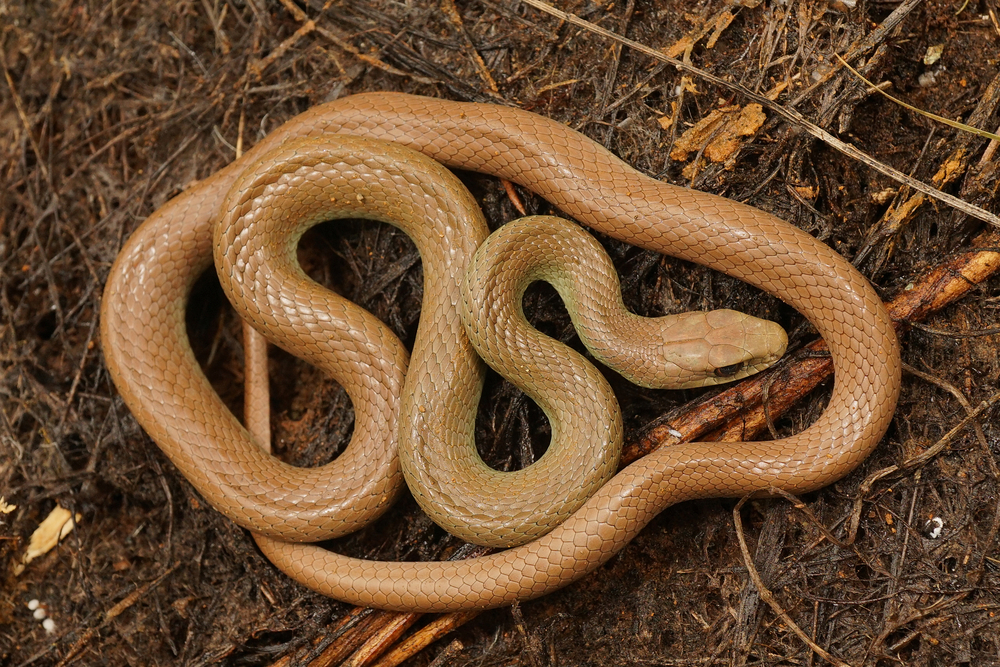
North American racers, or blue racers, are one of the longest snakes on the continent. They get their name from their ability to move at incredible speeds when frightened.
These animals have been recorded going at speeds of four miles per hour.
| Scientific Name: | Coluber constrictor |
|---|---|
| Range: | Throughout the state |
| Adult Size: | Up to 73 inches |
| Description: | The racer is a long snake with a strong, muscular body. It has a relatively short head but very large eyes with round pupils.
Its scales are slightly keeled so it has a relatively smooth look but with well-defined scales. The upper surface of the snake is black or bluish-gray and the underside is a whitish-yellow color. The snake has a long and well-defined tail. |
| Habitat: | A habitat generalist, but prefers open areas like open woodlands, prairies, meadows, and grasslands. |
| Venomous/Non-Venomous: | Non-venomous |
Northern Red-Bellied Snake – Storeria occipitomaculata
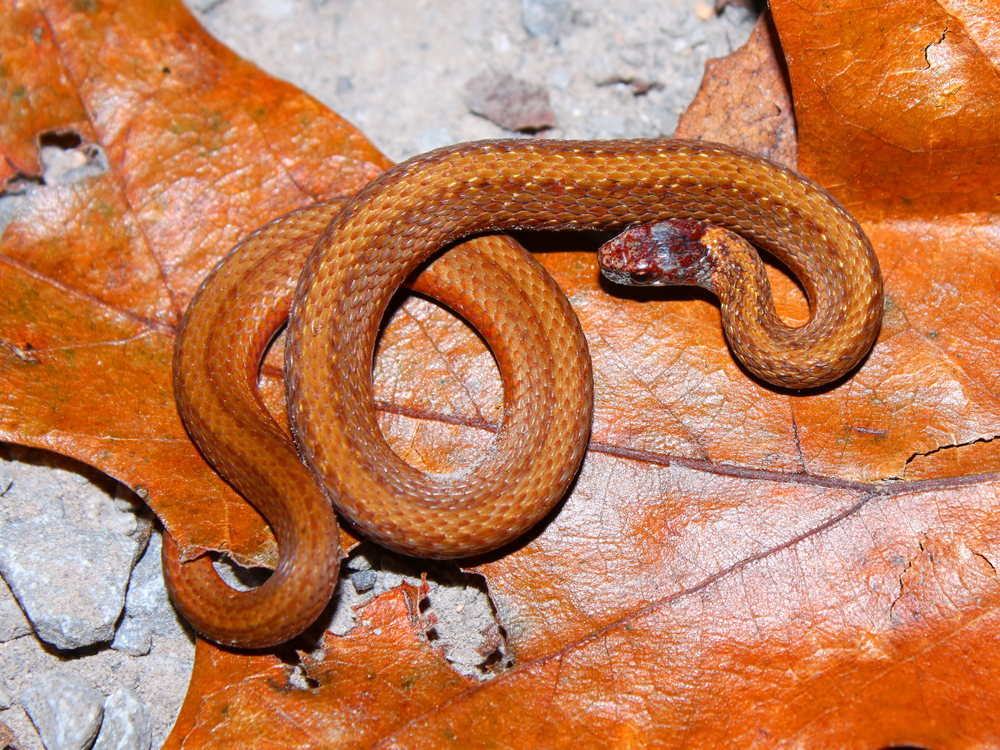
The Northern red-bellied snake is a close relative of the Dekay’s brown snake. However, it tends to be more particular about its habitat type.
It lives almost exclusively in deciduous forests, though it may wander when food is scarce.
| Scientific Name: | Storeria occipitomaculata |
|---|---|
| Range: | A scattered distribution in the Northern parts of the state |
| Adult Size: | Up to 10 inches |
| Description: | The red-bellied snake is similar in appearance to its relative, the brown snake.
While the brown snake is relatively neutral in color, the red-bellied snake has a bright red or orange underside which it uses to frighten predators. The upper surface is dark brown with light brown or gray stripes. it has a long well-defined tail, a short head, and round pupils |
| Habitat: | Prefers to live in well-vegetated areas like forests and woodlands, especially those with moist soils. |
| Venomous/Non-Venomous: | Non-venomous |
Venomous Snakes in Ohio
Ohio snakes don’t incorporate a large percentage of venomous species. Of the approximately 27 snake species in the state, only three are venomous.
Northern Copperhead – Agkistrodon contortrix
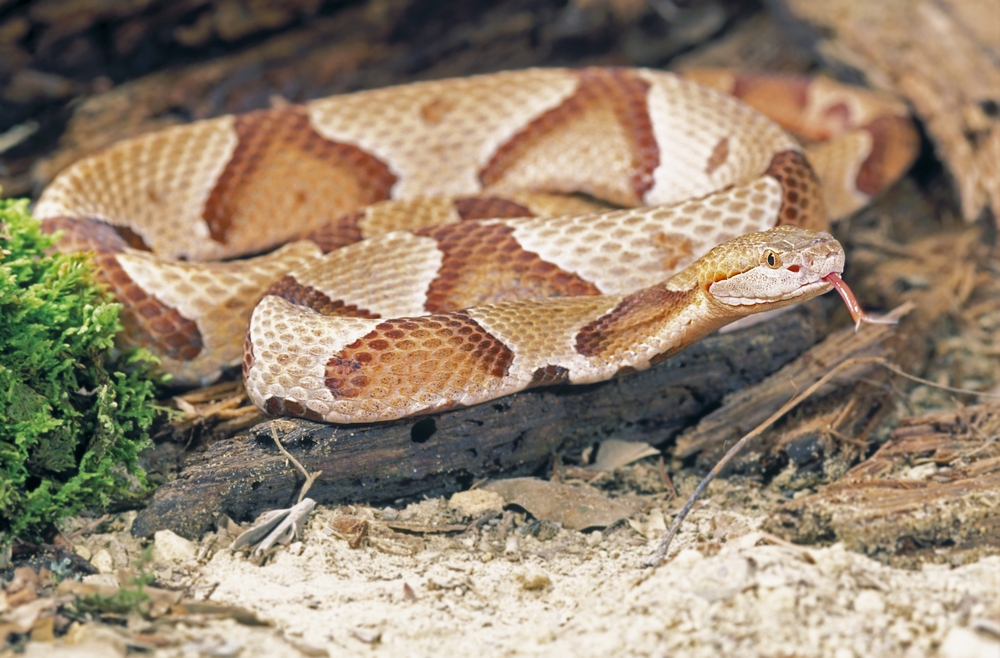
The Northern Copperhead is a medium-large pit viper that spends most of its time near water. It has a beautiful combination of colors that are coppery or bronze-like, hence the name.
It’s a close relative of the water moccasin, and people sometimes confuse the two. However, cottonmouths (water moccasins) don’t occur in Ohio.
| Scientific Name: | Agkistrodon contortrix |
|---|---|
| Range: | Only in the Southern parts of the state |
| Adult Size: | Up to 40 inches |
| Description: | The northern Copperhead gets its name from a distinctive bronze-like color that fills its head. The est of its body features similar shades of brown in a vast array of blotches that cover the entire upper surface of the snake.
In many specimens, the blotches take the form of well-defined bands of color. The snake has a broad head with two distinct light-colored bands down the side of the face. It has very large eyes which lack horns but have vertical, slit-shaped pupils. It has large heat-sensing pits between the eyes and the nostrils. This species doesn’t have a rattle. |
| Habitat: | Diverse, may be found in forests, plains, prairies, meadows, and grasslands, but prefers to live in wet areas like marshes, swamps, and floodplains next to rivers. |
| Venomous/Non-Venomous: | Venomous |
Timber Rattlesnake – Crotalus horridus
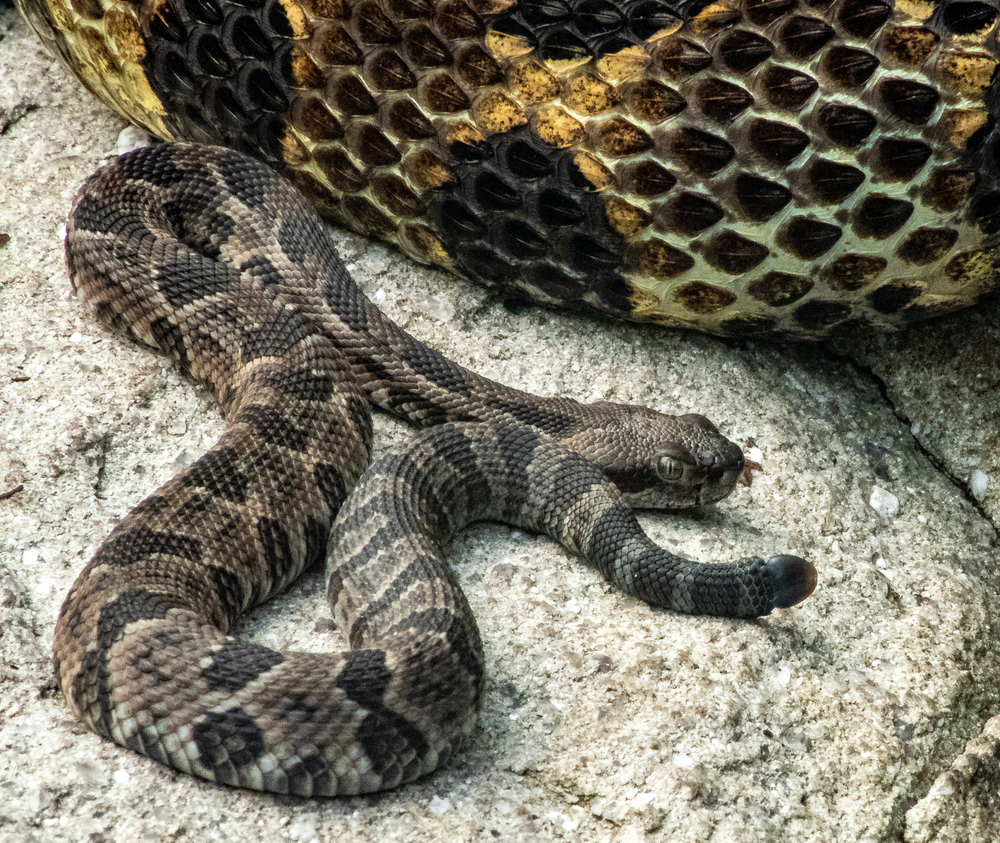
Timber rattlesnakes are some of the largest venomous Ohio snakes. As the name suggests, these animals typically dwell in forests and other tree-dense habitats.
| Scientific Name: | Crotalus horridus |
|---|---|
| Range: | Parts of the South and North of the state |
| Adult Size: | Up to 74 inches |
| Description: | The timber rattlesnake is a large-bodied snake with a robust build.
As with other pit vipers, it has a large head and large eyes with vertical, slit-shaped pupils. It also has heat-sensing pits between the eyes and the nostrils. The background color for the species is dark gray or brown with black or dark brown bands throughout the body. This species has a tail that has adapted to form a rattle. |
| Habitat: | This snake prefers vegetated areas like forests and woodlands, especially those located on mountainsides. |
| Venomous/Non-Venomous: | Venomous |
Massasauga – Sistrurus catenatus
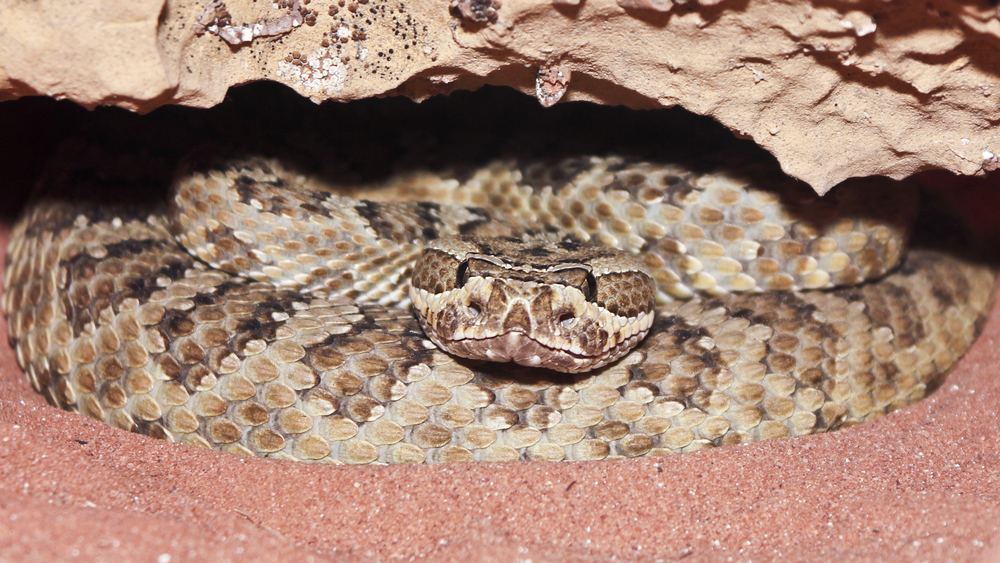
The Eastern massasauga rattlesnake is an endangered species in Ohio and protected by law. It’s also the smallest venomous species in the area.
It prefers to live near water sources and is semi-aquatic by nature.
| Scientific Name: | Sistrurus catenatus |
|---|---|
| Range: | Throughout the state, except in the South |
| Adult Size: | Up to 30 inches |
| Description: | The Massasauga is the smallest pit viper in the state. It has a robust body and a short tail which has adapted to form a rattle.
The snake has a large head and large eyes with slit-shaped pupils. It also has heat-sensing pits located between the eyes and the nostrils. The background color is light brown or gray with dark brown blotches all over the body. The head is gray or brown with bands running down the sides of the face. |
| Habitat: | Wet areas like fens, marshes, meadows, and floodplains alongside rivers and lakes. |
| Venomous/Non-Venomous: | Venomous |
Non-Venomous Snakes in Ohio
Most of the Ohio snakes are non-venomous species like the garter snakes and rat snakes. Let’s take a closer look at some of the species in question.
Black Rat Snake – Pantherophis obsoleta
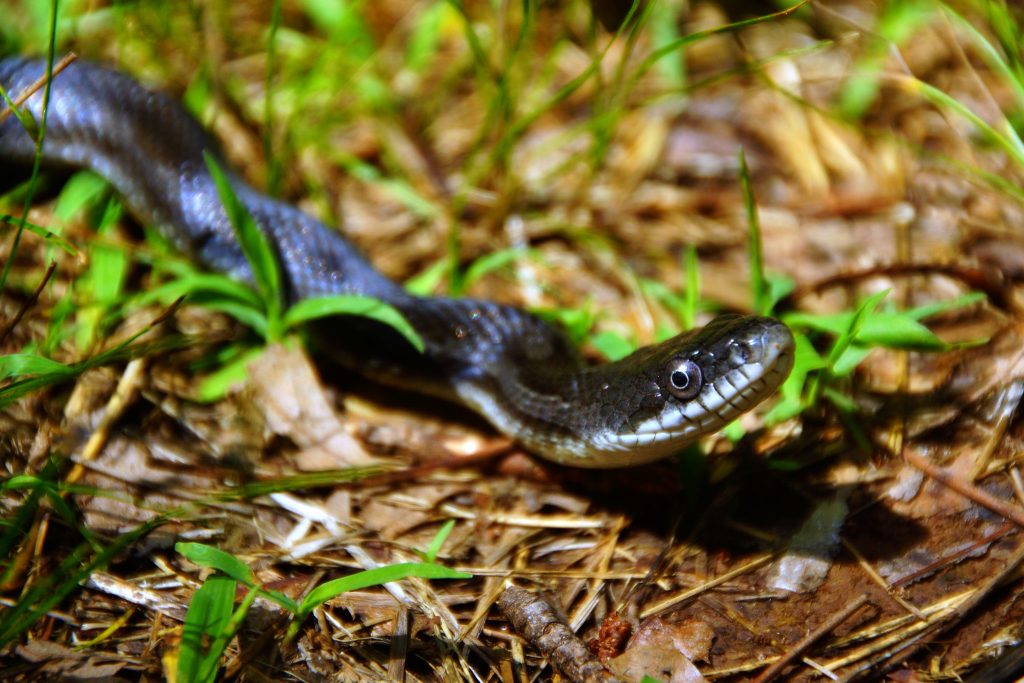
Image credit: Stephen Little (via CreativeCommons.org)
Finding a rat snake in Ohio is simple enough. However, the black rat snake hails from further west in the country and its range only partially covers Ohio.
This species can reach lengths of up to eight feet. More typically, it reaches lengths of around six feet.
At one point, it was considered the longest snake in North America. However, the Eastern Indigo snake, Drymarchon couperi, is longer – reaching lengths of nine feet or more.
| Scientific Name: | Pantherophis obsoleta |
|---|---|
| Range: | Debated, probably only in the Eastern portion of the state |
| Adult Size: | Up to eight feet – one of the longest snake species in North America |
| Description: | A large snake with a robust body and a long well-defined tail.
It has a shiny black surface color and a brilliant white underside. The snake’s neck and chin are also white. It has two prominent eyes with round pupils and an average-length head that’s no wider than its body. |
| Habitat: | A habitat generalist that is often seen in Meadows, fields, savannahs, and other types of grassy plains. However, it will happily travel to any location with sufficient food sources. |
| Venomous/Non-Venomous: | Non-venomous |
Green Snakes – Genus Opheodrys
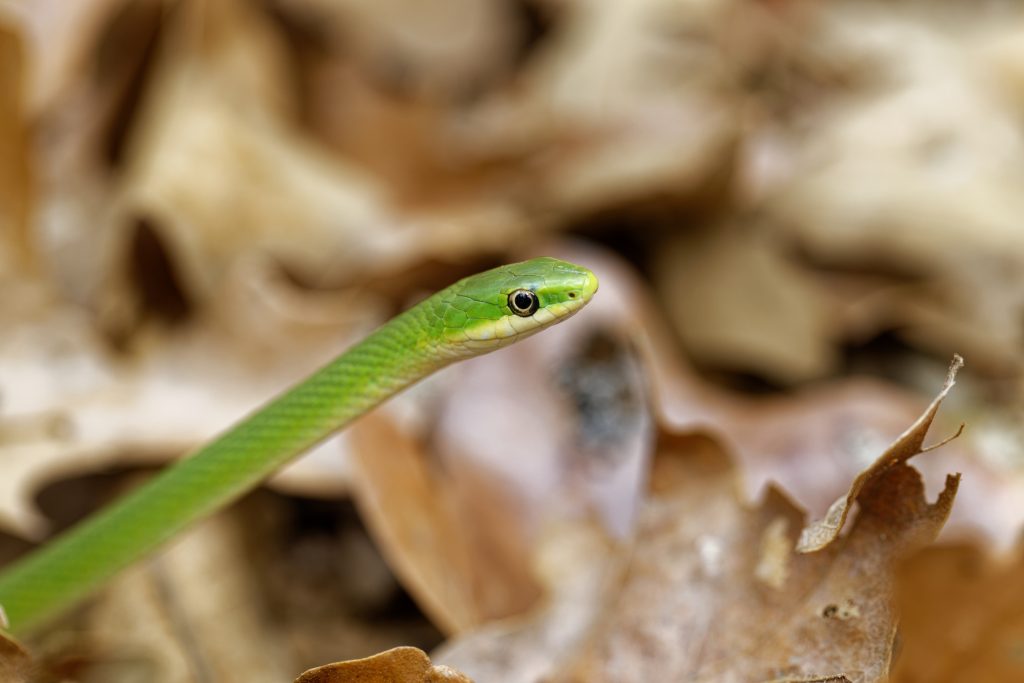
The rough and smooth green snakes are very similar, except for their scales. Rough green snakes have strongly keeled scales which give them a rasp-like appearance.
These animals often visit well-watered gardens where they feed on small rodents and birds.
| Scientific Name: | Opheodrys aestivus – Rough Green snake
Opheodrys vernalis – Smooth Green snake |
|---|---|
| Range: | Only in the Southern part of the state (aestivus) and the far North (vernalis) |
| Adult Size: | Up to 32 inches for the rough green snake, and up to 20 inches for the smooth green snake. |
| Description: | Robust snakes with long, stout bodies and bright green coloration. The underside is yellow or white as is the snake’s “chin”.
It has a long well-defined tail, a long head no wider than its body, and round pupils. In the rough green snake, the scales are keeled giving it an almost rasp-like appearance. The smooth green snake doesn’t have such strongly keeled scales, giving it a smoother appearance. |
| Habitat: | Moist habitats with plenty of grass such as wet meadows, savannahs, old fields, and the borders of streams and rivers.
Often resides in moist forests and woodlands. |
| Venomous/Non-Venomous: | Non-venomous |
Smooth Earth Snake – Virginia valeriae
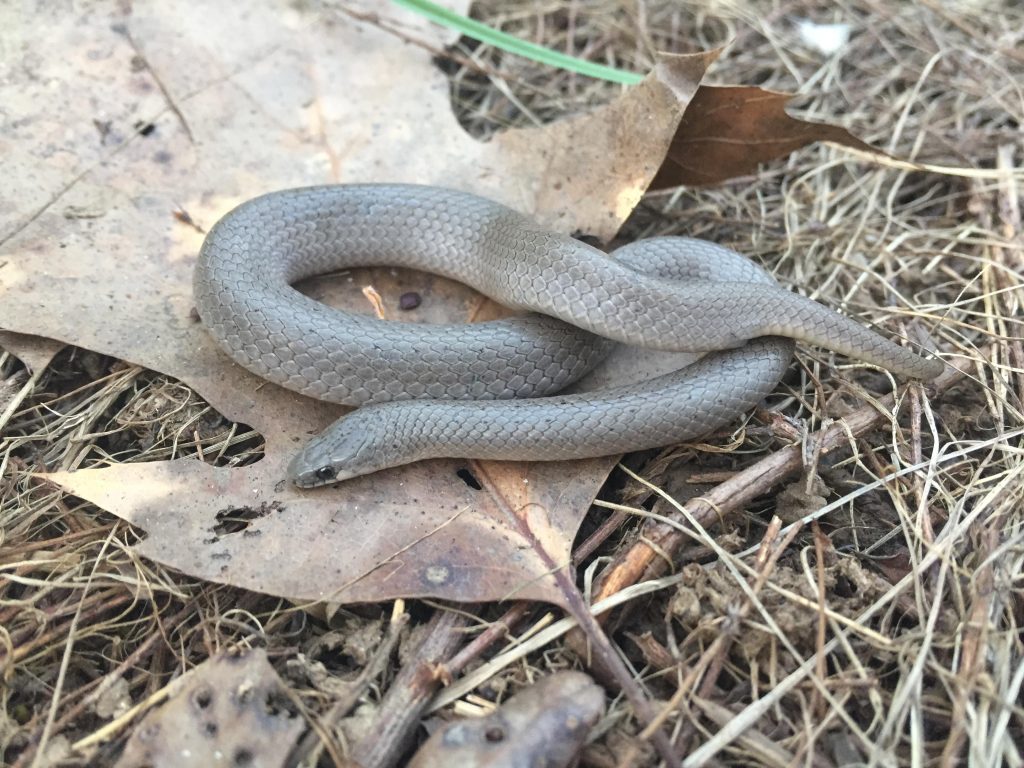
Image credit: u/ImagesOfNetwork (via Reddit.com)
The smooth earth snake gets its name from its color, and its terrestrial habits. It has unkeeled scales, which gives it a smooth appearance.
| Scientific Name: | Virginia valeriae |
|---|---|
| Range: | Only in the far South |
| Adult Size: | Up to 15 inches |
| Description: | A well-built brown snake with a relatively short body and a slightly elongated head. It has scales without keeled edges, unlike the rough earth snake, which shares its habitat in other States.
The belly is a creamy white color, the tail is well-defined, and the snake’s pupils are round. |
| Habitat: | Diverse kinds of forests and woodland habitats, but most common in deciduous forests and the transition zones between two habitat types. |
| Venomous/Non-Venomous: | Non-venomous |
Eastern Hog-Nosed Snake – Heterodon platirhinos
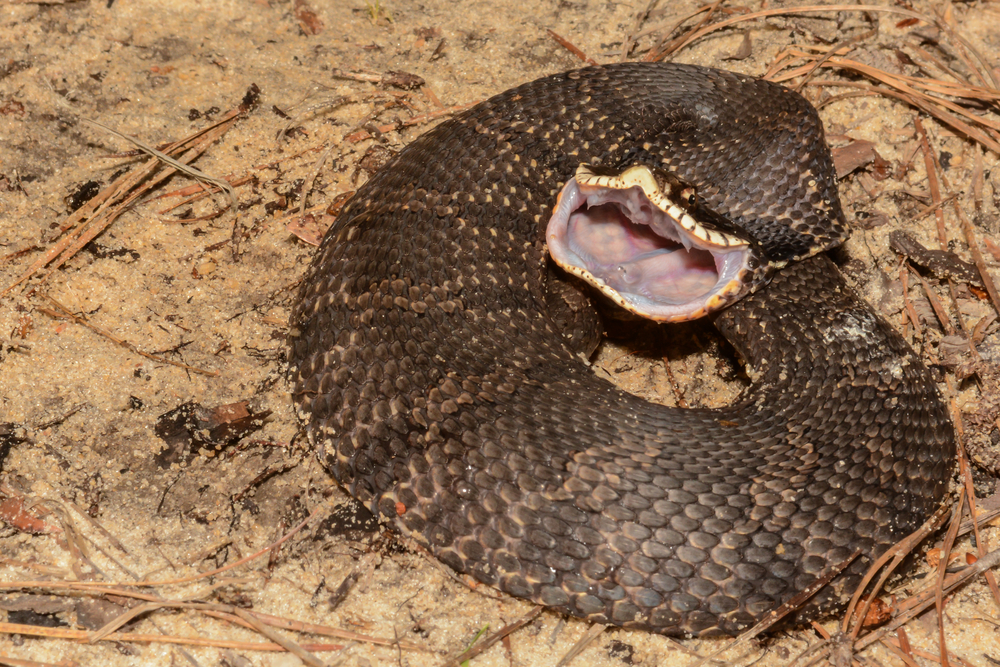
It’s almost impossible to mistake the hognose snake for any other species. Its distinctive, flattened head and neck make it stand out.
These animals mainly feed on frogs and toads and often reside near water sources. However, they prefer dry soils, so they likely feed mainly on the toads that bury themselves in these soils.
| Scientific Name: | Heterodon platirhinos |
|---|---|
| Range: | Absent in a band that runs from the Central part of the West to the Northeast |
| Adult Size: | Up to 46 inches |
| Description: | The Eastern hognose snake has a unique appearance that instantly separates it from other snakes in the area.
It has a severely flattened head and neck which become exaggerated even further when the snake is angry. While its broad head might be similar to that of the pit vipers, it’s far too flat to truly resemble them. Its pupils are round. It has a unique coloration and pattern which features bold bands of color (typically in tan) in various shades of brown and black. It has a robust body that ends suddenly at a sharply pointed tail. |
| Habitat: | Areas with dry and sandy soils such as meadows, prairies, and cultivated fields. Often found in woodlands and forests, as long as they’re not overly wet.
These snakes often live in dry habitats bordering rivers, swamps, and other freshwater sources as they feed mainly on frogs and toads. |
| Venomous/Non-Venomous: | Non-venomous |
Eastern Worm Snake – Carphophis amoenus
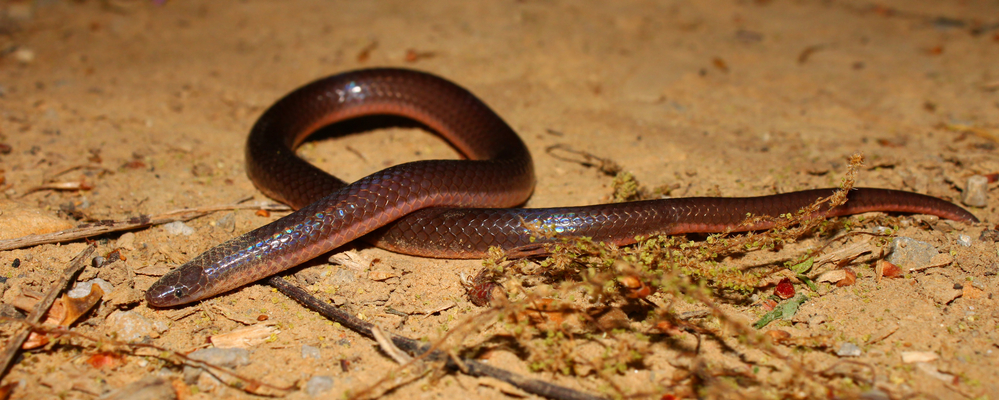
The Eastern worm snakes truly look like overgrown earthworms. They also like to burrow, so you’ll only see them near soft, moist soils.
They live in the soil for the most part, but also burrow in pursuit of the termites and ants that they prefer to eat. The larvae of these insects are firm favorites among worm snakes.
| Scientific Name: | Carphophis amoenus |
|---|---|
| Range: | Only in the South and Southeast of the state |
| Adult Size: | Up to 11 inches |
| Description: | A small snake that in many ways resembles an overgrown earthworm. It’s a light pink-brown or purple-brown color and has a well-defined tail.
The head is well-rounded and the tiny eyes have round pupils. |
| Habitat: | Vegetated habitats with moist soils that are soft and easy to burrow in. |
| Venomous/Non-Venomous: | Non-venomous |
Kirtland’s Snake – Clonophis kirtlandii
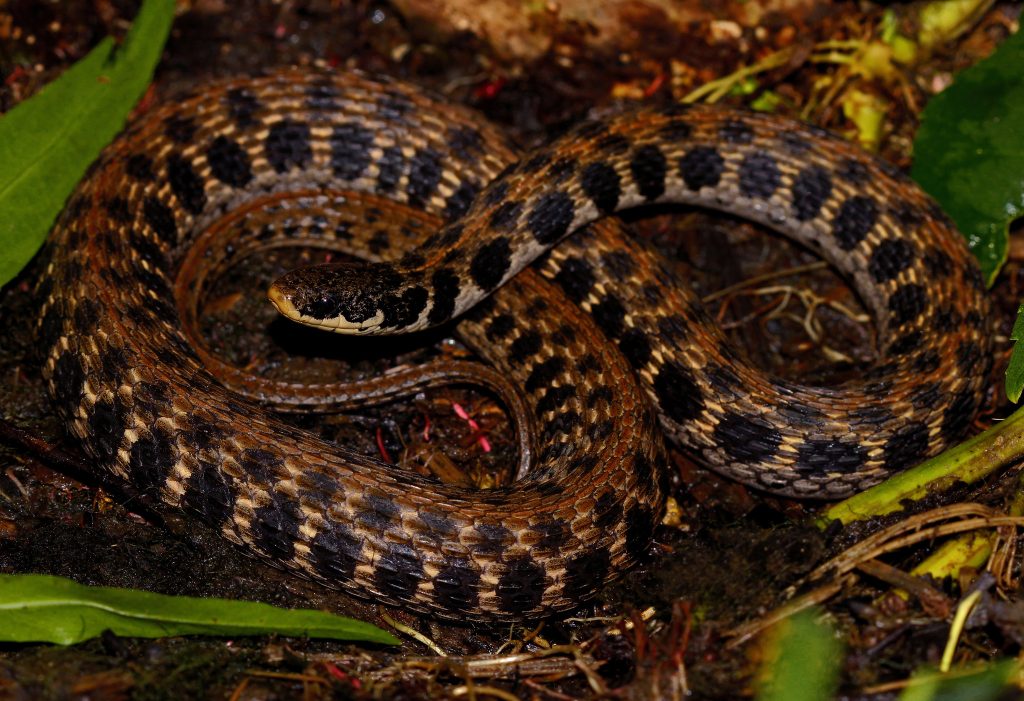
Kirtland’s snake is a small, but striking, species with a pronounced reddish-brown stripe down its belly.
It’s not common and is classed as a threatened or endangered species in parts of its range.
| Scientific Name: | Clonophis kirtlandii |
|---|---|
| Range: | Throughout the state, except the far East |
| Adult Size: | Up to 18 inches |
| Description: | These are small snakes with relatively mellow coloration. Their patterning is striking, and the snake has an orange-brown band down the center of its belly.
The head is similar in shape to that of the corn snake and it has round pupils. |
| Habitat: | Wet habitats like wet prairies and meadows, marshes, fens, swamps, and river plains. |
| Venomous/Non-Venomous: | Non-venomous |
Black King Snake – Lampropeltis nigra
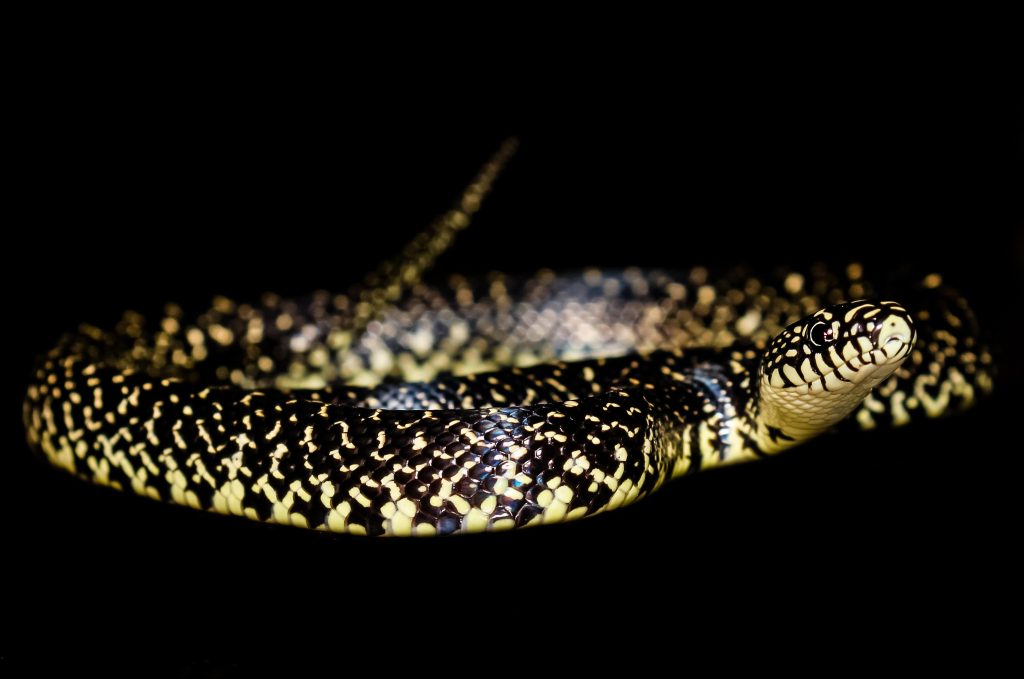
Image credit: u/domesticgnome (via Reddit.com)
The black king snakes and their relatives, the Eastern milk snakes, are harmless species that are fairly common throughout their range.
These snakes are opportunists and will live wherever abundant food is available. Kingsnakes are popular pets thanks to their easy-going nature and willingness to accept rodent prey.
| Scientific Name: | Lampropeltis nigra – Black Kingsnake |
|---|---|
| Range: | Throughout the state |
| Adult Size: | Up to 72 inches |
| Description: | It has a rounded head with round pupils.
A long, stout-bodied snake with the musculature which is characteristic of constrictors. The black kingsnake is a glossy black color. The body tapers to form a well-defined tail. |
| Habitat: | A generalist though not as much as the black and grey rat snakes. It prefers habitats like abandoned farms and piles of debris. It also likes to live in habitats near freshwater. |
| Venomous/Non-Venomous: | Non-venomous |
What You Need to Know
Most of the fear people have towards snakes is rooted in misconception. By educating yourself, you can learn to live alongside snakes without fear:
- Snakes don’t want to eat you, or pursue you – they consider humans to be predators.
- Usually, snake bites are the result of someone harassing a snake, or accidentally stepping on one.
- Snake bites are rarely fatal – only around five of the 7,000 snake bites in the US every year are fatal.
- Most of the snake species you see in your garden or around your home are harmless species like Eastern ribbon snakes.
- You should never try to catch, kill, or otherwise molest a snake that you find. If it needs to be removed, call in a professional.
Snake Safety 101

It’s fairly easy to keep yourself safe from snakes as long as you follow a few simple guidelines:
- Always wear sturdy shoes when you go walking, hiking, or jogging.
- Never enter an area that’s so overgrown that you can’t see where you’re walking.
- When in a park, forest, or other “wild area” keep your pets on leashes and your children near you at all times.
- Keep your eyes open and pay attention to where you’re stepping when you enter a potential snake habitat.
- Stick to well-trodden, well-marked hiking and jogging trails – you’re less likely to step on a snake accidentally if you can see where you’re going.
About Venomous Snakes
Typically, you can have all the snakes in the world slithering around you, and you’d hardly notice. Why? Because they’re as eager to get away from you as you are to get away from them.
This rule usually applies to venomous snakes as well. However, the pit viper is a somewhat different creature, and you’re more likely to get bitten by one.
It’s not that timber rattlesnakes are more aggressive than garter snakes or that they’re out to get you – it’s a matter of protection.
Vipers rely on camouflage to protect them from your attention. Because they blend in so well and don’t try to get away from you, it’s easy to step on them by accident.
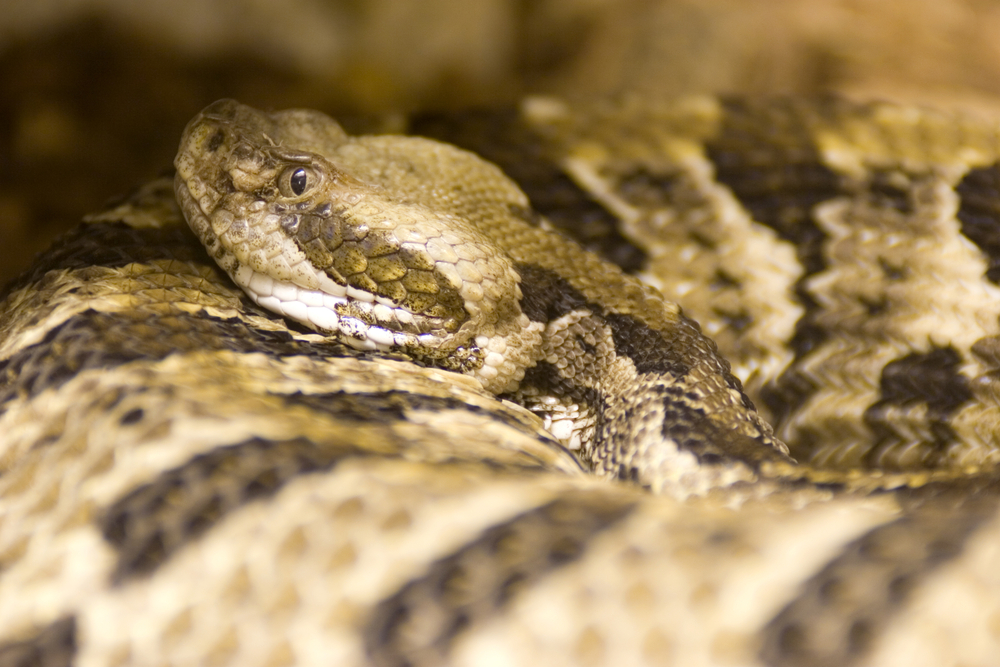
This is why it’s essential to stick to well-worn paths, wear sturdy shoes, and pay careful attention to where you’re walking.
Remember, less than 1% of snake bites in the US are fatal, thanks to modern medicine.
If You Encounter A Snake
When you encounter a snake, you don’t usually need to do anything. The list of things you shouldn’t do is considerably longer.
If you encounter a snake, don’t:
- Try to catch or kill the snake
- Approach the snake in any way
- Panic – there’s no reason to, and it won’t help you
What you should do is:
- Back away to a safe distance
- Call for help, if the snake poses a danger to anyone or is in danger
- Leave the snake alone, unless you want to take photos or observe from a safe distance
When To Call For Help
There are only two situations when you’ll need to call for help if you find a snake:
- If the snake has bitten you, someone else, or someone’s pet
- If the snake is in danger or poses a threat to others (i.e. you find a rattlesnake on a pathway in the park)
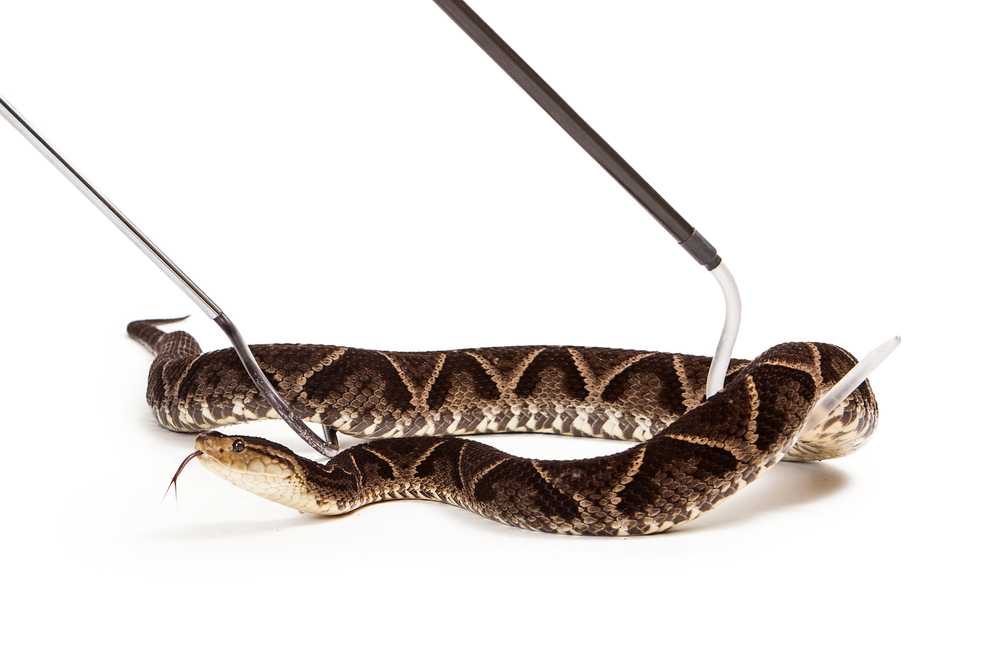
If you encounter either of these situations, call the relevant authority using the resources I’ve shared below.
What to Do if a Venomous Snake Bites You
If a venomous snake bites you, you need to know exactly what to do. Over the years, people have come up with many ideas, and some of them will kill you faster.
Snakebite victims shouldn’t:
- Try to catch and kill the snake
- Inject themselves with antivenom
- Eat or drink anything other than water
- Try to treat the snakebite with home remedies
- Exert themselves physically – it will accelerate the spread of the venom
- Panic – it makes your heart beat faster, spreading the venom through your body more quickly
- Try to suck the venom from the wound – at best, it will do nothing, at worst, you’ll poison yourself
Snakebite victims should:
- Call 911
- Stay calm
- Try to keep the bitten area still
- Contact a loved one or friend who lives nearby (if possible)
- Apply pressure to the wound to keep the poison from spreading
- Splint the affected limb and wrap it tightly, keeping it below the level of the heart
Useful Resources
I’ve created a list of useful resources that can help you deal with the snakes in your area.
Emergency Poisoning Advice
If a snake bites you, someone else, or a pet, you’ll need the following contact details:
- ASPCA Poisoning Hotline: 1-888-426-4435
- Poison Control Center’s national hotline: 1-800-222-1222
Snake Relocation Services
Many different wildlife removal companies in Ohio can remove snakes for you. Your local office for the Ohio Division of Wildlife should also have a list of licensed removers.
You can also try the Free Snake Relocation Directory on Facebook if you’d like to get someone who’s passionate about snakes.
Educational Resources
iNaturalist is an excellent resource for learning more about the snake species in your area, and the other wildlife. You can also connect with other people who have an interest in snakes.
You might also want to check out this slideshow of snakes native to Ohio.
Related Articles to Ohio Snakes Identification Guide
If you’re interested in other identification guides, check out our:
- Arizona Lizards Identification Guide
- Tennessee Snakes Identification Guide
- Pennsylvania Snakes Identification Guide
You can also check out our other articles on snakes – we have vital guides that you can learn from!
